

THE FCC: WHERE IT ALL BEGAN
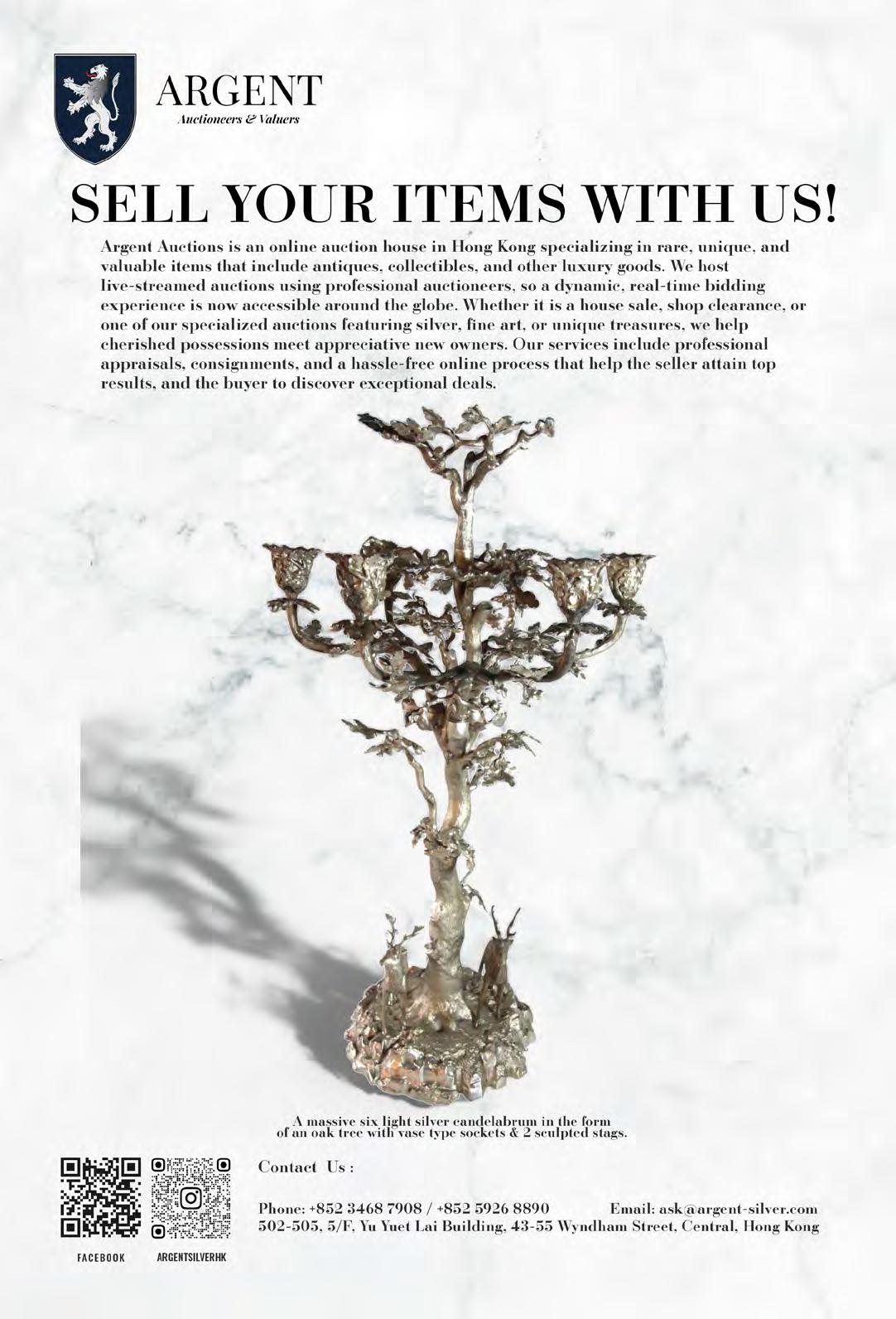
FROM THE PRESIDENT

Dear Members,
At the end of May we started another cycle of the Board year. Our new Board, whom you will meet in this issue of The Correspondent, represents some of the very best of our Club - dedicated and eager Members who will work to represent you in the coming year. No year is an easy year for the FCC, but I am confident that we have the right governance in place on our Board and the right leadership in our Club staff that we will be able to tackle any challenges we face with aplomb.
First and foremost, my goal for this year is to have our lease renewed when it is up at the end of December. Being restricted to a three-year lease is certainly a challenge, but the Board and staff are actively communicating with the appropriate parties to indicate our eagerness to renew the lease, and we feel that we consistently demonstrate our value as part of the Hong Kong community. The FCC holds a special and influential place in the city, as a hub for conversation, a support for professional journalists, and a social centre for our Members. Our dedication to our historic building is also readily evident in the HK$5.2 million restoration we completed last year. I am confident that we will maintain our place in Hong Kong for the foreseeable future.
As we move forward into the year, I hope our Members will see the Board’s active work to push the standards of our Club higher. Our speaker events, such as the goodbye luncheon for David Webb in May, are unique offerings. We strive to offer our Members opportunities to discuss and question everything from the state of trade in the region to F1 racing to menopause with world-class experts and fellow FCC Members. These events will continue to be central to the FCC and I welcome suggestions and feedback to develop these events further.
Likewise, our Members benefit from having the FCC as a centrally located place to hold work meetings, drinks with friends, and celebrations with family. We want to push beyond just maintaining that by constantly improving our food and special offerings. Members should feel like the FCC is their go-to spot, and our regular and special menus should reflect that. And yes, we are working on improving the coffee ASAP.
In the coming year, I hope you, as Members, feel empowered to contribute to the Club’s growth. The Board and staff welcome feedback, but there is ample opportunity to join a committee and get involved in charity work through the FCC. In the case of the latter, the FCC has spent the past year revitalising its charity efforts by coordinating with nine partner charities to connect volunteers and share the expertise we have in the Club. Check out our website or ask the front desk for more information on how to get involved.
Being a Member of the FCC is a privilege, and working with you in the coming year will be an honour and an absolute joy. I look forward to a year where the FCC will not just survive but thrive in Hong Kong.
Best Regards,

Morgan M. Davis President
PHOTO: BEN MARANS
The Foreign Correspondents’ Club, Hong Kong
2 Lower Albert Road, Central, Hong Kong
Tel: (852) 2521 1511
Fax: (852) 2868 4092
Email: fcc@fcchk.org
Website: www.fcchk.org
The Board of Governors 2025-2026
President Morgan M. Davis
First Vice President Karen Koh
Second Vice President Tim Huxley
Correspondent Member Governors
Jennifer Jett, Kristie Lu Stout, Peter Parks, Paul Tait, Laura Westbrook, Lee Williamson, Jing Yang, William Zheng
Journalist Member Governors Zela Chin, Joe Pan
Associate Member Governors
Liu Kin-ming, Lynne Mulholland, Christopher Slaughter, Barbara Yu Larsson
Club Treasurer Tim Huxley
Club Secretary Liu Kin-ming
CONTRIBUTORS
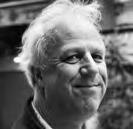

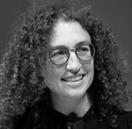
John Batten
John comments, broadcasts and writes on art, culture, urban planning, heritage and policy issues. He is also a director of the arts education group Rooftop Institute and currently President of AICAHK.
Professional Committee
Conveners: Morgan M. Davis, Jennifer Jett, Karen Koh, Lee Williamson, William Zheng
Press Freedom Committee
Conveners: Morgan M. Davis, Karen Koh, Lee Williamson, Jing Yang, William Zheng
Constitutional Committee
Conveners: Liu Kin-ming, Peter Parks
Membership Committee
Conveners: Zela Chin, Jennifer Jett, Joe Pan
Communications Committee
Conveners: Zela Chin, Morgan M. Davis, Paul Tait
Finance Committee
Treasurer: Tim Huxley Conveners: Karen Koh, Lynne Mulholland
House/Food and Beverage Committee
Conveners: Lynne Mulholland, Barbara Yu Larsson
Building – Project and Maintenance Committee
Conveners: Liu Kin-ming, Christopher Slaughter
Wall Committee
Conveners: Kristie Lu Stout, Peter Parks
Charity Committee
Conveners: Morgan M. Davis, Laura Westbrook
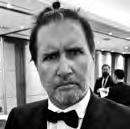
Hugo Novales
Hugo is the FCC’s in-house journalist, covering events for the website and social media, contributing to The Correspondent, and helping organise and promote workshops for early/midcareer journalists.
Adrienne Raphel
Adrienne is the author of Thinking Inside the Box: Adventures with Crosswords and the Puzzling People who Can’t Live Without Them, Our Dark Academia , and What Was It For.
Editor Ann Tsang Email: editor@fcchk.org
Publisher Artmazing! Noel de Guzman Email: artmazingcompany@gmail.com
Cover image Melville J. Jacoby
Printing Elite Printing: Tel: 2558 0119
Advertising Enquiries FCC Front Office: Tel: 2521 1511
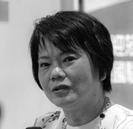

Aaron Busch
Aaron is the FCC’s first Social Media Journalist Member, writing on various online outlets since 2020. He splits his time between news reporting and cricket commentating, as well as broadcasting in Hong Kong and internationally. His nightly Substack on Hong Kong news can be found at tripperhead.com
Christina Pantin
Christina is a Malaysia-born, U.S. citizen who is fluent in financial journalism and corporate communications. She is the Founder of communications consultancy Toot and a founding member of Global Commtrepreneurs Network and Web3 Women.
Carsten Schael
After two decades of membership of the FCC, including six years on the Board, Carsten champions a deeper appreciation of the Club’s history. He is still working to collect details on some of its lost chapters.
The Correspondent ©2025
The Foreign Correspondents’ Club, Hong Kong
TheCorrespondent©2025ispublishedfourtimesayearbyTheForeignCorrespondents’Club, HongKong.Allviewsexpressedinallarticlesarethoseoftheauthorsandarenotnecessarily thoseofTheForeignCorrespondents’Club.AllcontentcontainedwithinTheCorrespondent magazinemaynotbereproducedinanymannerwhatsoeverwithoutauthorisation.
CONTENTS

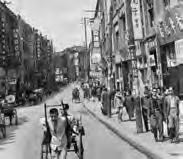
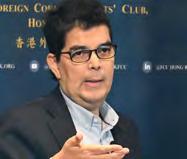



1 From the President 4 Club News
6 The FCC Journalism Conference 2025: The Way Forward
For the second year in a row, the FCC welcomed speakers, presenters, journalists, correspondents and students to its Journalism Conference. More than 100 attendees packed into multiple FCC rooms for the full-day event. Member Christina Pantin captures the highlights.
10 VOA: To Be, Or Not To Be?
In an interview specially recorded for the FCC Journalism Conference, veteran journalist and former White House Bureau Chief for Voice of America Steve Herman discusses the challenges that VOA faces, the implications for press freedom, and his advice for the next generation of journalists.
12 Chungking 1943: The Birth of The FCC
The FCC shows its history on the walls and in its worn floors, but when, how and where did it actually begin?
16 David Webb: Master of Enigmas
Not surprisingly, David Webb's farewell Fireside Chat at the FCC was sold out less than an hour after registration opened. The Correspondent looks back over the event and Webb’s life well lived.
20 Whispers of Saigon
In the year of the 50th anniversary of the Fall of Saigon, John Batten looks at Vietnamese influences in Hong Kong and delves into the controversy surrounding one of the Vietnam War’s most powerful photographs.
24 Member Focus
Polo Bourieau: On The Cutting Edge
Meet sculptor extraordinaire and now book author, the irrepressible Polo Bourieau.
30 The Errant Aesthete
From the 1940s through to her death at the age of 94, photographer Lillian Bassman’s images broke boundaries and made her a truly creative force of the 20th and 21st centuries. Using unconventional techniques in the darkroom to create unique, mysterious and moody photographs, Bassman was a woman way ahead of her time.
34 On The Wall
36 The Life and Times of The Paris Metro
What began as a whimsical idea in the City of Light became a beloved publication that captured the spirit of Paris, its expats, and its quirks with equal parts wit and wonder. So how did three journalists, armed with little more than typewriters, café tabs, and a stubborn refusal to take “non” for an answer, pull it off?
38 The Talese Way
Internationally acclaimed author Gay Talese never lets technology get in the way of finding a great story.
40 Staff Spotlight: Tony Yu/Demi Chef
42 Food For Thought: An Homage To Spanish Cuisine
44 In Vino Veritas
The Spirited Journey of Tequila. A Splash of Rosé
46 Reciprocal Club: The British Club Bangkok 48
ANNOUNCING THE NEW BOARD
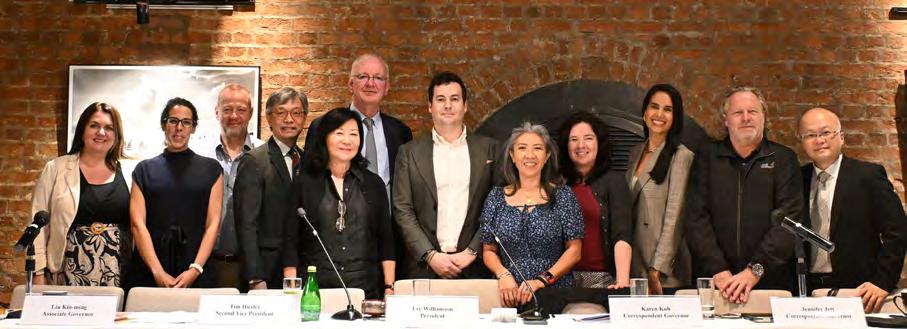

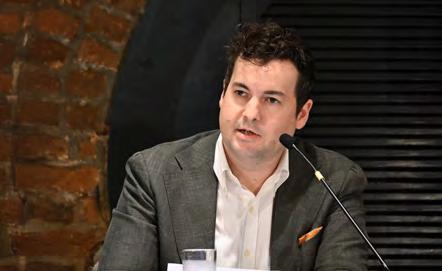
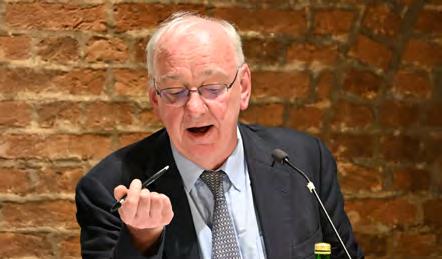
Congratulations to the new FCC Board of Governors for 2025-2026. The incumbents began serving following the Annual General Meeting on 29 May, 2025.
The newly elected President of the FCC is Morgan M. Davis, who commented: “In the nine years I have been in Hong Kong, the FCC has become my second home. I am very excited to serve the Club as President in the coming year, and I am optimistic about the future of our Club as a key part of the Hong Kong community. The FCC offers value unlike any other with its location, events, and menu, but its true value comes from the impressive and diverse membership.”
We would like to thank the outgoing Board members for their service.
The new Board members are listed below. Please note that this is an updated announcement, after the tied vote for the Correspondent Governor position was resolved on 23 May.
PRESIDENT: Morgan M. Davis
FIRST VICE PRESIDENT: Karen Koh
SECOND VICE PRESIDENT: Tim Huxley
CORRESPONDENT GOVERNORS
Jennifer Jett
Kristie Lu Stout
Peter Parks
Paul Tait
Laura Westbrook
Lee Williamson
Jing Yang
William Zheng
(NB: There was a tied vote for the 8th Correspondent Governor position. One of candidates decided to withdraw).
JOURNALIST GOVERNORS
Zela Chin
Joe Pan
ASSOCIATE GOVERNORS
Liu Kin-ming
Lynne Mulholland
Christopher Slaughter
Barbara Yu Larsson
‘THE TERROR OF WAR’ AT THE FCC
For more than 50 years, Nick Ut’s searing photograph of nine-year-old Kim Phuc fleeing a napalm attack in Vietnam has been synonymous with the horrors of war. The Pulitzer Prize-winning image, widely known as ‘The Terror of War’/‘Napalm Girl’, captured a moment of unimaginable human suffering and helped shift public opinion against the war. However, half a century later, the photograph and its legacy have become mired in controversy, with questions about its authorship dividing the photojournalism community.
A signed print of this image hangs in The Bunker at the FCC bearing the following caption: Nick Ut (Huynh Cong Ut/Associated Press) “Phan Thi Kim Phuc running down a road near Trang Bang, Vietnam, after a napalm bomb was dropped on the village of Trang Bang by a plane of the Vietnam Air Force. The village was suspected by U.S. forces of being a Viet Cong stronghold. Kim Phuc survived by tearing off her burning clothes.”
Kim Phuc (aged 9; middle left) runs naked in the street. Also pictured are her older brother (aged 12; far left), younger brother Phan Thanh Phuoc (aged 5; background left, looking back) and younger cousins Ho Van Bo and Ho Thi Ting (boy and girl, respectively; middle right). Taken on 8 June 1972, Ut was awarded the 1972 Press Photo of the Year by the World Press Photo Awards and a Pulitzer Prize in 1973 for the image. As a result, Kim Phuc attracted great attention for many years.
In response to the questionable doubt as to whether Ut took the image, the following statement from The Wall Committee has been added below the photograph:

‘The Terror of War’, colloquially known as ‘Napalm Girl’, is one of the most indelible works of war photography ever taken. The FCC’s Wall Committee acknowledges the controversy surrounding the photo’s attribution. The World Press Photo group has suspended the attribution to Nick Ut. This follows the release of ‘The Stringer’, a documentary that questions the authorship of the photograph. Ut has repeatedly dismissed allegations that he did not take the photo. The AP launched an investigation and found “no definitive evidence” to justify changing the attribution. The photograph itself remains undisputed and will remain on display at the Club.
For more details on this story, please see pages 21-22.
DIPLOMATS GATHER AT THE CLUB
A regular feature on the FCC calendar, on 26 May, Consuls General and diplomats gathered at the Club for an evening of cocktails and conversation with our Board, Journalist and Correspondent Members. We would like to extend our sincerest thanks to everyone who attended.
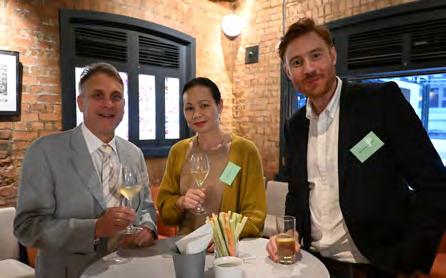



THE FCC JOURNALISM CONFERENCE 2025 LEADING THE WAY FORWARD
For the second year in a row, the FCC welcomed journalists, correspondents, students and speakers to its Journalism Conference. More than 100 attendees packed into multiple FCC rooms for the full-day event. Member Christina Pantin interviewed speakers, moderators, and attendees to capture the highlights.
By Christina Pantin

On 3 May, the FCC hosted its annual Journalism Conference that up to last year had been on hiatus for five years. The date was not coincidental – it was World Press Freedom Day – also the date of the 151st running of the storied Kentucky Derby in Louisville.
The FCC’s now former President Lee Williamson managed to weave both events together as he welcomed attendees for the conference themed ‘The Way Forward.’
Supported by Monocle, the gratis conference took up most of the Club’s dining spaces that day (thank you Members for your forbearance!).
But “hacks” and horses? To much laughter, Wllliamson noted that the Derby favourite was a champion called ‘Journalism’. As punters were wagering on the classic race, the journalism profession, Williamson stated, “has always been a good bet.” ‘Journalism’ (the horse, that is) didn’t win, beaten by ‘Sovereignty’. We’ll stop with the analogies there.
There’s no question that the practice of journalism both locally and globally has become tougher than ever. If you missed it, take a look at The Correspondent’s April edition for the FCC Press Freedom Survey results. Williamson’s observation? With 62 percent of respondents stating that their working environment has worsened since the last survey, a question that he often hears is whether journalism is dead in Hong Kong.
“It can’t be,” he declared, urging the audience not to “put down tools”, but to “build up their toolboxes.”
Build we did. Seven speakers and three moderators discussed investigative journalism; the career of a freelancer; the use of AI to unearth stories; journalists’ mental health; and how two of the world’s biggest newspapers cover Asia with the onslaught of the Trump 2.0 news juggernaut. The FCC’s Resident Journalist Hugo Novales interviewed Steve Herman, now ex-Chief National Correspondent and former White House Bureau Chief at the embattled Voice of America, one of the many targets of the Trump administration’s cost cuts.
Seven workshops featuring 16 speakers provided the building blocks for reporting on Hong Kong, pitching story ideas to editors, writing a book, ensuring accuracy in reporting, inclusivity in covering news, and hands-on AI for journalists.
Many questions were asked, and answered, and as Williamson observed, it was heartening to hear how often the questioners would introduce themselves as “a student from” one of Hong Kong’s universities.
As the first Keynote Speaker of the day, Selam Gebrekidan, an investigative reporter for The New York Times based in Hong Kong, shared some of her most notable experiences in her job so far and offered advice to both early-career and experienced journalists alike in the audience.
IMAGE: FCCHK
Lee Williamson

AI x Journalism
Omnipresent AI was a hot topic. We heard from Jaemark Tordecilla from the Philippines, who builds AI tools for newsrooms in developing countries, and discussed how AI has helped to extract stories from the daunting morass of government budget documents in the Philippines.
Tordecilla was recently quoted in a Reuters Institute article by Gretel Kahn that discussed keeping certain countries’ native languages alive in the age of AI news. “For the longest time, [transcription] worked well for English and it didn’t work at all for Tagalog, so journalists in the Philippines are only very recently getting to use these tools for their own reporting, but cost is an issue,” he noted while describing instances where Filipino journalists have been forced to share accounts for paid subscriptions to transcription tools, which can create security issues. “The rollout for support for regional languages has been slow and they are being left behind.”
A workshop run by News Corp’s Editorial AI Quality Control Engineer Brett McKeehan, an AI innovator and digital transformation leader, gave attendees a hands-on introduction to the various AI Large Language Models and different use cases, featuring real-life story examples. “Finally, we have a mass disruption event with technology in our favour. Our entire industry will be non-recognisable in five years because of AI, and it’s far better to be ahead of this curve than behind it,” said McKeehan.
“AI is best utilised to support our stories, not replace us. It’s a damn good tool,” he added, urging all journalists to make learning to use AI a priority: “But please, be ambitious in how you use it; tell stories that haven’t been told.”
South China Morning Post graduate trainee Fan Chen said the AI workshop was her favourite session. “Before this, I used AI tools almost guiltily - as if relying on them somehow
compromised my integrity as a journalist, but Brett’s session reframed my perspective. AI isn’t a threat that will replace us, but a collaborator that handles the tedious tasks and frees us up to focus on what truly requires a human touch: interviews, investigation, storytelling, and fact-checking.”
For Fan, McKeehan’s most memorable line was this: ‘‘You won’t be replaced by AI - you’ll be replaced by journalists who use AI.”
Reporting in Hong Kong
Moderated by Connor Mycroft, a reporter with the South China Morning Post’s Hong Kong desk, two workshops aimed to provide the “state-of-play” for journalists in the SAR, “from the impact of the two national security laws on newsroom operations to the breadth of reporting still possible in the city despite challenges.”
“I wanted attendees, particularly those who were students or at an early stage in their careers, to walk away hopeful about their future in journalism here,” remarked Mycroft.
Echoing the FCC’s Press Freedom Survey results, Mycroft touched on the sea change across newsrooms in Hong Kong over the past five years. “Risk management has become an important tool for those in the media. More people are turning to a more passive reporting style, or a conservative take on the profession…Despite this, the breadth of reporting is still vast in Hong Kong. Whether you work for an international or local newsroom, it is still possible to do in-depth investigations, report on political matters, and tell human interest stories with an impact.”
Journalists and mental health
A topic that is still often buried is how journalists handle their mental wellbeing while covering crisis stories and being in situations that are potentially life-threatening.
Opening keynote speaker Selam Gebrekidan
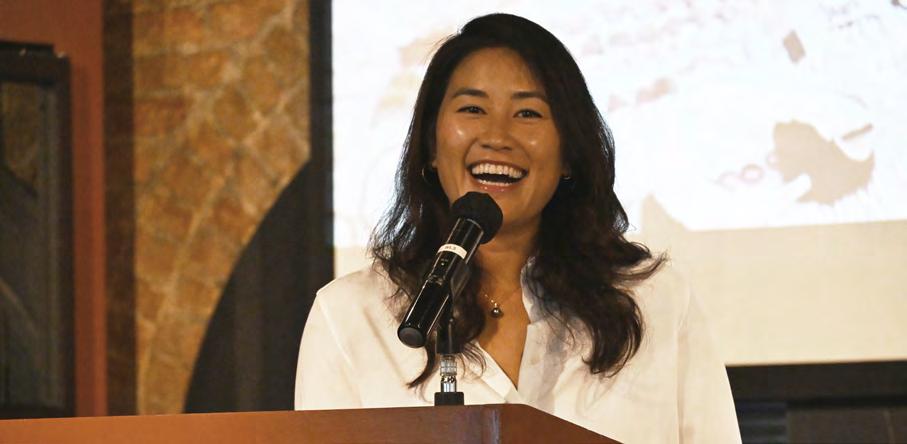
The Information’s Asia Bureau Chief Jing Yang shared her own experiences while moderating a trio who offered advice and findings on this topic. “It is estimated that one in eight people worldwide suffers from mental illness, and in Hong Kong, the ratio is one in seven,” noted Yang. “I suspect it may be even higher among journalists in Hong Kong, given the high-pressure nature of our work. Yet despite its prevalence, mental health is still not discussed enough in our industry.”
Yang also stated that destigmatisation is the first step toward fostering a healthier culture and environment for journalists, adding that employers have a responsibility to provide better training and to support the cost of treatments, which can be expensive, especially in Hong Kong.
Her advice to journalists? “Be mindful of your mental state; listen to what your minds are signalling, and respond accordingly before reaching breaking point.”
Inclusivity in reporting
Language matters in journalism, and even more so when reporting on situations that involve gender and ethnicity. Given the power of the media to shape and influence perceptions and behaviours, two workshops focused on the need for sensitivity when reporting on these subjects.
NBC News’ Asia Desk Fellow and one of this year’s FCC Clare Hollingworth Fellows, Jay Ganglani, moderated both panels. “The biggest takeaways were to be mindful of the language that we use when covering minority communities,” commented Ganglani. Also, when covering such, it’s important to recognise that we need to treat them with empathy and with the same level of respect that we would apply to everyone else. For instance, if a robbery was carried out by Hong Kongers of South Asian descent, is it really necessary to mention their ethnic background? How important is that to the actual story?”
Ganglani also noted that some of the audience questions focused on tools to help improve gender-sensitive reporting,
such as the Stylebook for Gender-Sensitive Reporting issued by the Asian American Journalists Association-Asia and offered in Chinese, Korean, Bahasa Indonesia and Tagalog, as well as English. “I think the discussion on unconscious bias, in particular, was extremely helpful and eye-opening for all of us in the room,” he said.
Wrapping it up
Freelance journalist Laurel Chor delivered the Closing Keynote Address, offering an insightful overview of her dynamic multimedia career. Her journey began with roles at now-defunct media outlets Vice and Coconuts, before evolving into photographing gorillas in central Africa, covering the war in Ukraine as a photojournalist, producing documentaries on climate change, and investigating the ivory trade. A National Geographic Explorer and multiple award-winning journalist, Chor also participated in a panel discussion on mental health. Addressing aspiring journalists, she shared valuable advice, emphasising: “You don’t need anyone’s permission to go out and tell stories…anyone can publish a story.”
Khunsha Dar, an art history and journalism student at The University of Hong Kong, was particularly impressed by Chor. “I found her keynote on her career journey to be particularly inspiring, especially as she has built such a diverse portfolio, both in terms of topic and medium. It made someone like me who has only really been looking into writing, perhaps want to venture into photography as well!”
Underscoring the theme of moving forward, the FCC offered all conference attendees a CV advice workshop and a professional headshot session on 17 May.
As always, a great deal of work behind the scenes made the conference a rousing success. A special thanks must go to the Journalism Conference Sub-Committee led by Dean Napolitano, and to the always welcoming FCC staff for making the event a warm experience for both Members and guests. Look out for the 2026 edition! n
Closing keynote speaker Laurel Chor
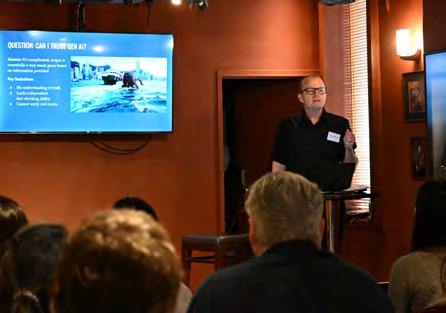
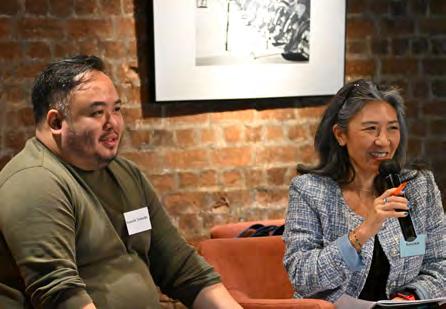

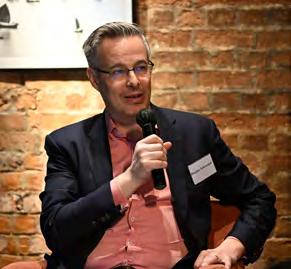

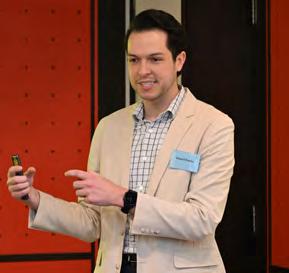


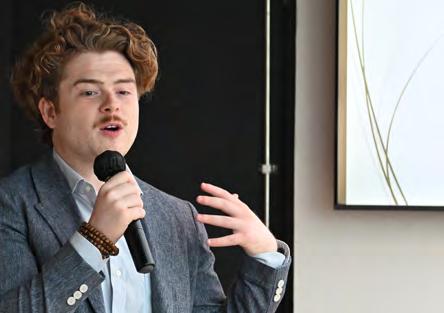
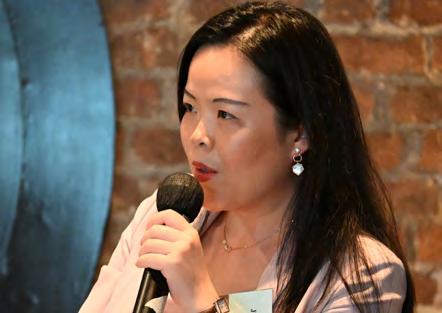
Brett McKeehan
Jaemark Terdecilla and Karen Koh
Connor Mycroft
Jing Yang
Kathryn Giordano
Douglas Schorzman
Robin Harding
Daniel Funke
Jennifer Deayton
Jake Soriano
VOA: TO BE, OR NOT TO BE
Steve Herman is a veteran journalist and former White House Bureau Chief for Voice of America (VOA). With a career spanning decades, he has reported from conflict zones, covered major global events, and championed press freedom. Recently, Herman found himself at the centre of a legal battle to preserve VOA’s independence amid unprecedented political interference. In this interview, specially recorded for and originally screened at the FCC Journalism Conference, Herman discusses the challenges that VOA faces, the implications for press freedom, and his advice for the next generation of journalists.
Interview by Hugo Novales
Voice of America (VOA) was established in 1942 during World War II as an anti-propaganda tool against the Nazis and Axis forces. Since then, it has expanded to encompass nearly 50 languages, targeting regions where press freedom is limited. However, this year has been tumultuous for VOA. Can you walk us through what happened? This year has been unprecedented. In January, Trump was inaugurated for a second term. Then in February, his administration announced it would cut 90% of USAID’s foreign contracts - a move I tweeted about. By March, Trump signed an executive order cutting funding for VOA’s parent company, the U.S. Agency for Global Media (USAGM). This led to thousands of VOA employees, including me, being placed on administrative leave. Our global broadcasts were replaced with music, and operations essentially came to a halt. However, in April, a federal judge blocked the Trump administration from dismantling VOA and mandated that we return to work.
This timeline has been surreal, especially for me personally. I was the first to be suspended, weeks before 1,300 of my colleagues. I was placed on paid administrative leave pending an investigation into my social media. It signalled that certain people in VOA management and USAGM were pre-emptively appeasing the administration. My successor as White House Bureau Chief, Patsy Widakuswara, was also removed from her post, despite doing an excellent job. Both of us had previously pushed back against political interference during the first Trump administration.
What shocked us most was the mid-March shutdown: broadcasts halted, satellite transponders were deactivated, radio transmitters shut down, and leases with radio affiliates in places such as Africa cancelled. The VOA website hasn’t been updated since mid-March. If VOA isn’t dead, it’s in a deep coma.
When you first started working at VOA, did you ever imagine something like this happening?
Not at all. I thought VOA was invulnerable to political interference because of its firewall and charter. The firewall prevents government interference in journalism, and the

charter mandates fair and balanced coverage, reflecting diverse American perspectives. VOA is neither the voice of Democrats nor Republicans.
There were some challenges during previous administrations, but we had bipartisan support in Congress. This time, that support is absent. Capitol Hill Republicans are not pushing back against these cuts. The situation feels different now because the attacks began early in Trump’s second term, and we still have three-and-a-half years ahead.
You have mentioned the role of the “DOGE factor” in the VOA shutdown. Can you elaborate on what that is and how it has influenced the situation?
The “DOGE factor” refers to the Department of Government Efficiency (DOGE), which has played a significant role in the current situation. DOGE was established to streamline government agencies, but many see its actions as heavyhanded, with an agenda to downsize or reshape organisations seen as inefficient or misaligned with the administration’s goals.
Kari Lake was appointed as a special adviser to USAGM. Initially, she spoke about reforming VOA, emphasising the need for efficiency and modernisation. However, after DOGE intervened, it seemed as though even Lake was caught offguard. Over one weekend, USAGM and VOA were abruptly deemed unsalvageable. Lake quickly changed her stance, publicly declaring that VOA was a “rotten fish from the head down” and could not be saved.
DOGE’s actions have led to the total shutdown of VOA’s operations under the pretext of a “pause” while they determine how to cut it down to the “statutory minimum”. This term, which they use frequently, implies they are reducing VOA to a bare-bones operation, far removed from its historic role as a global broadcaster.
This approach has been challenged in court. Two federal judges have already ruled that DOGE’s actions, and by extension the Trump administration’s policies, are “arbitrary and capricious”. The courts have also emphasised that such drastic changes violate the First Amendment and represent executive overreach. However, the administration
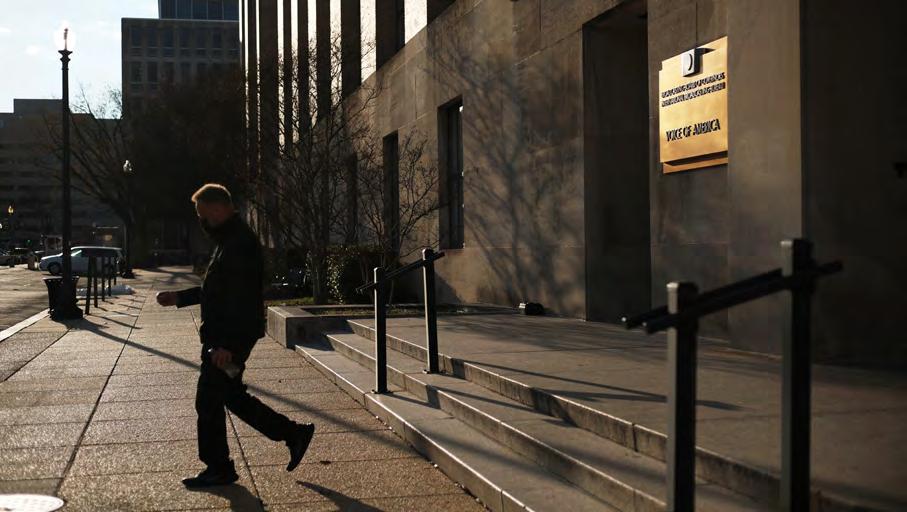
continues to appeal these rulings, leaving VOA in a state of limbo.
The DOGE factor represents a broader trend of dismantling institutions under the guise of efficiency. Its impact on VOA is profound, as it directly undermines the organisation’s ability to fulfil its mission of providing reliable, unbiased news to global audiences.
There have been accusations labelling you as antiAmerican. How do you respond to those?
I’m far from anti-American. My work upholds VOA’s charter, and I consider myself a patriot. By defending the Constitution and fighting for press freedom, I am honouring American values. Two federal judges have already supported us. Most notably, Judge Royce Lamberth, a Reagan appointee and conservative Republican, issued a scathing opinion against the government’s actions. It’s unfair to call him - or me - radical or anti-American.
There were reports of VOA self-censoring stories critical of Trump before the shutdown. Why do you think that happened?
I call it “anticipatory obedience” - a fear-driven attempt to appease those in power. Some believed that toning down coverage would prevent harsher actions. I opposed this
approach. Self-censorship goes against everything the First Amendment stands for. Fear is pervasive not just in media but also in academia and other institutions. It’s a troubling trend in the U.S., and it undermines the role of journalism.
What has been VOA’s impact in regions like Hong Kong and mainland China, and what do Trump’s actions mean for those areas?
VOA’s Mandarin service has been central to its mission for decades. It played a crucial role in providing accurate information during the COVID-19 outbreak, countering confusion and misinformation from China. VOA broadcasted critical updates to China via television, radio and online platforms. The current shutdown jeopardises this vital work. It’s a disservice to the regions that rely on VOA for unbiased news.
What advice would you give to the next generation of journalists?
Journalism isn’t easy - it requires passion and resilience. It’s not the most lucrative career, and the number of good jobs is shrinking. You’ll face pushback from all sides, but if you have the fire in your belly, you’ll persevere. Know your rights, stand firm, and be ready to defend yourself - sometimes with legal help. n
UPDATE: HERMAN RESIGNS TO JOIN THE UNIVERSITY OF MISSISSIPPI
VOA employees have filed lawsuits against the Trump administration, the USAGM and two senior advisers, hoping to reverse the layoffs and job losses. Those cases remain pending, but an appellate court decision has allowed the layoffs to remain in place for now.
Since the interview was recorded, Herman has resigned from the outlet and joined the University of Mississippi as the first executive director of the school’s Jordan Center for Journalism Advocacy and Innovation.
Herman said he was joining the University at a time when accurate and timely information is core to shaping the country’s foundation of democracy. “That requires an all-hands-on-deck approach,” he said. “Not all these challenges that we face with journalism and the First Amendment at the core can be solved only by journalists. We need a lot of help.”
CHUNGKING, 1943: THE BIRTH OF THE FCC
Walking through the doors of the FCC always fills me with a bit of anticipation. You never quite know who you might bump into or what news or chatter you will hear. This institution shows its history on the walls and in its worn floors, but when, how and where did it actually begin?
By Carsten Schael Images by Melville J. Jacoby
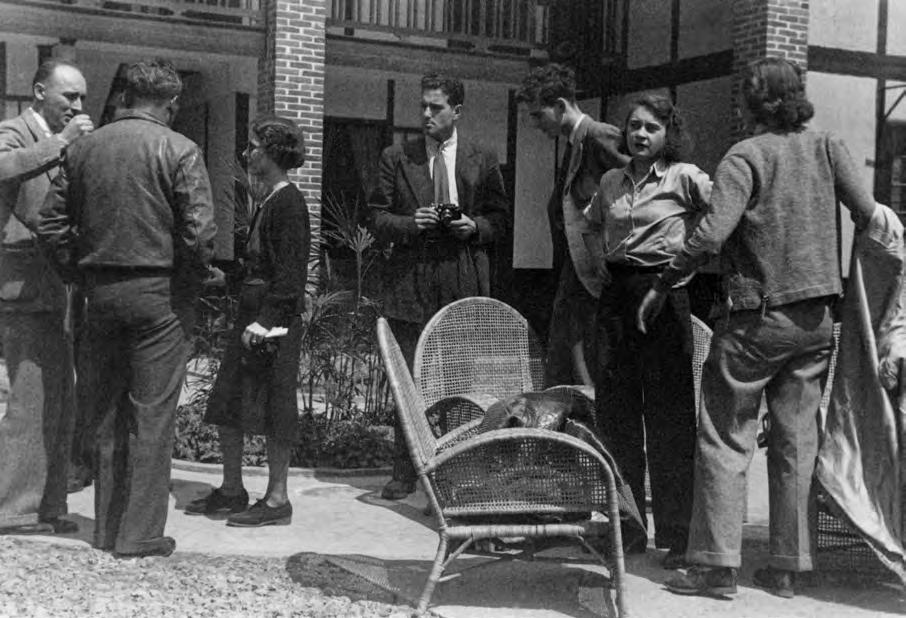
Various celebrations over recent decades have commemorated the FCC’s historic past, but the exact story of its origin seem to become diluted with each generation of past Members’ first-hand accounts of events fading with the passage of time.
In April this year, the Van Es Wall exhibition traced the life of American war correspondent Melville J. Jacoby, whose story, illuminated by historian Bill Lascher’s 2024 book A Danger Shared , offers an accurate window into the FCC’s beginnings. As the curator of the exhibition, I delved into the Club’s nascent days, with the aim of piecing together the saga of resilience and resolve.
Picture yourself in 1940, a young correspondent far from home, bound for a China fractured by the Japanese occupation. Still free, Western China had defiantly made Chungking its capital, with the Nationalist Government (KMT) under Chiang Kai-shek administering this hold-out. Your journey ends on a rattling plane, diving through clouds to a sandy airstrip carved out of the Yangtze River’s embrace.
Amid the hustle and bustle of the plane’s arrival, you head through crowds of people up the steps on a steep hillside to a former school compound that now houses the KMT Information Ministry and a Press Hostel.
Settling into your spartan shared accommodation, you very
Correspondents gather outside the Press Hostel in Chungking for a birthday party
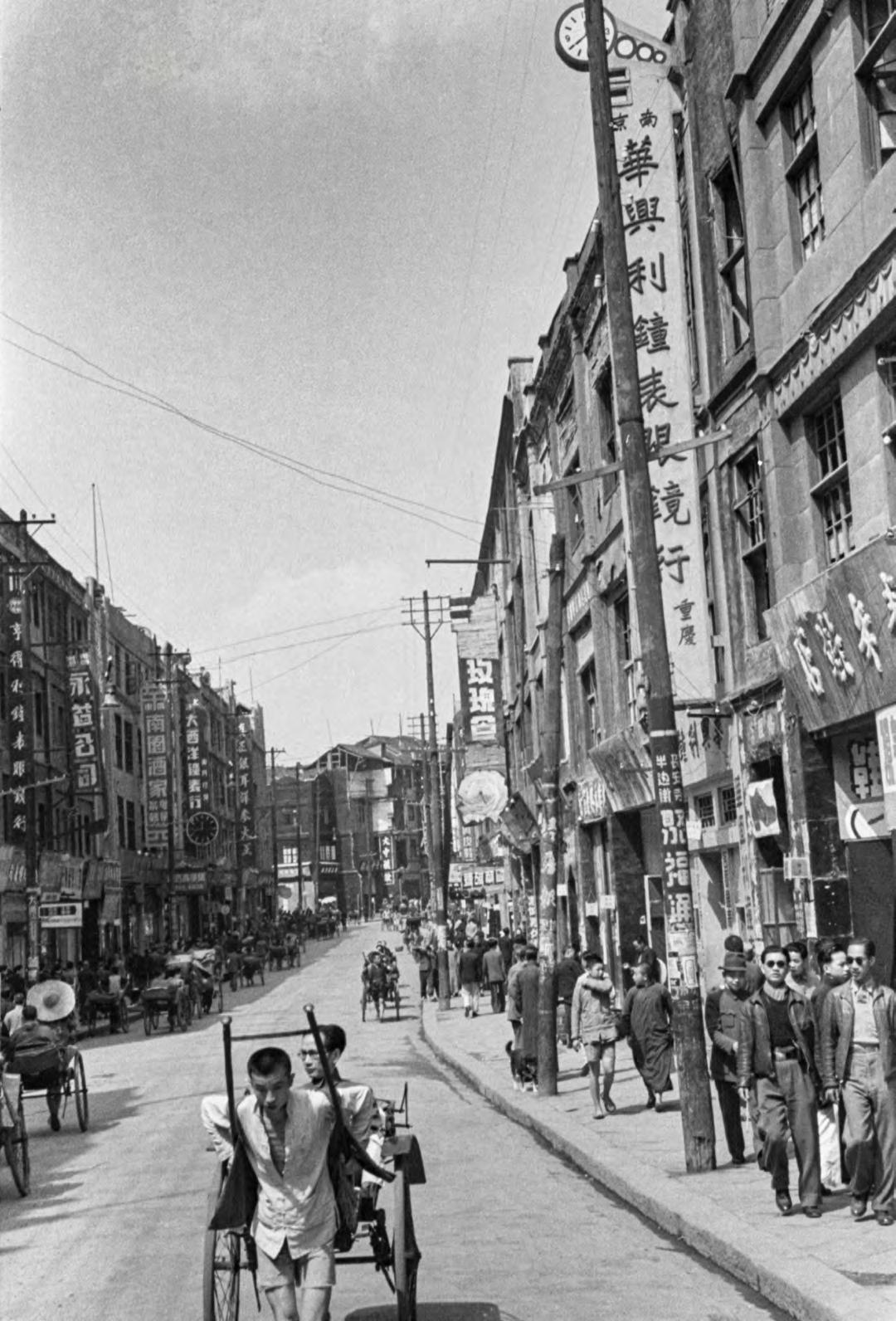
Chungking street scene, circa 1940s
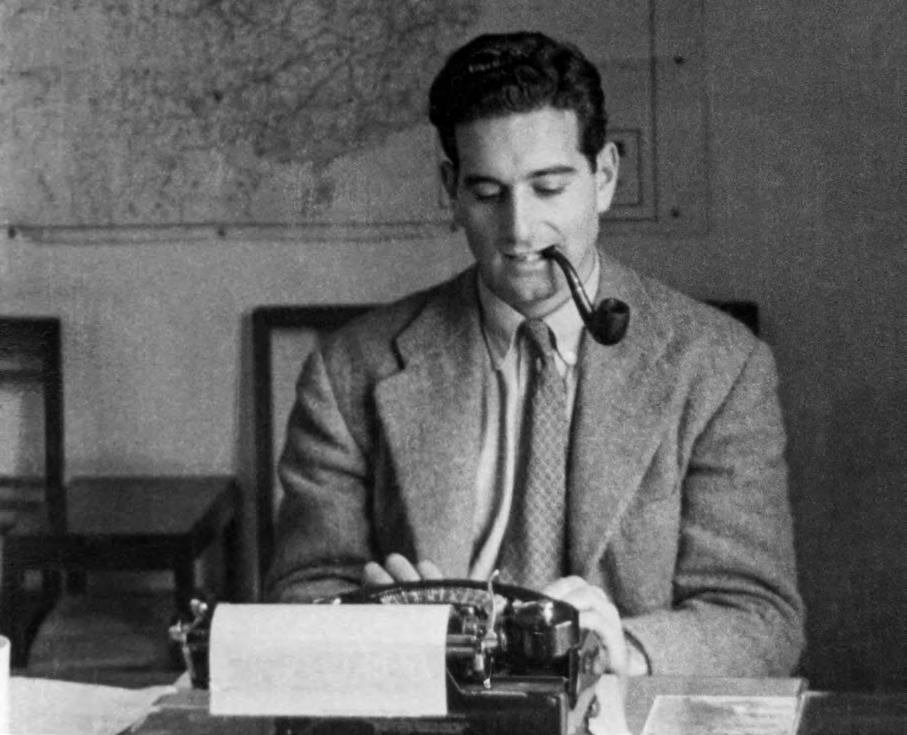
soon meet the other residents who represent news outlets and organisations from across the globe. China’s struggle with the occupying forces is a developing story that could potentially have further implications for the war in Europe, even though the audiences outside Asia are barely aware of this yet.
Meanwhile, Chungking is a frequent target of Japanese air attacks that make the experience of war dramatically real. The mostly young journalists are united in their daily struggles to report the news. The police challenge their frontline appearances after air raids, the KMT military bulletins do not always present the real facts, all news reports have to pass the press censors - which can take up to 48 hours - before they are allowed to be transmitted overseas. Therefore your reports age faster than you and your editors alike.
Frustration foments action. By July 1941, seven correspondents, united by shared grievances, band together. They pen a bold memorandum to Chiang Kai-shek, demanding reforms. The Generalissimo’s response brings temporary relief, but the demands for timely reporting persist.
Lascher’s meticulous research reveals the tipping point:
on 18 May, 1943, a small group of journalists, holed up in the Press Hostel at the Pahsien Middle School Compound, resolved to form a collective voice. Thus, the Foreign Correspondents’ Club was born.
The Club’s founding officers, as recorded in the 1944 China Handbook, included Vadim Sidelnikov of the Tass News Agency, Theodore “Teddy” White of TIME magazine, and Spencer Moosa of the Associated Press. Other charter members, according to more contemporary accounts, included Thomas Chao of Reuters, M. Yakshamin of Tass, and Brooks Atkinson of The New York Times. This nascent body, forged in adversity, vowed to champion the interests of its members and the truth they sought to tell.
By July 1943, the FCC marked its arrival with a reception in the garden of the Press Hostel, a gathering that drew Chinese officials, foreign diplomats, and local press. Dr. Hollington K. Tong, the KMT Vice Minister of Information who established the hostel, addressed the crowd, as did Atkinson, the Club’s first President. Their words cemented a tradition of bridging divides - between nations, cultures, and perspectives – which remains part of the FCC’s mission today.
TIME magazine correspondent Melville J. Jacoby working at his typewriter
“…as correspondents who are personally sympathetic for China in a struggle against aggression, we strongly object to the constant surveillance to which we are subjected in the course of our activities in Chungking.”
The Memorandum quoted here (drafted in June 1941) is the first time that correspondents came together to represent their professional interests to the authorities at the time. It can be argued that this represents the nucleus from which The Foreign Correspondents’ Club emerged. The content of the below is reproduced as originally written.
Suffering as much as anyone in Chungking this week, the foreign press took a terrific pounding from the Japanese, received a semi-feeble promise from the Generalissimo to improve their working conditions.
Not the easiest capital in the world to cover, Chungking presents a teasing array of difficulties to the correspondent. No newsmen in the Chinese capital has a motor car. Yet after each bombing they walk the city determining damage. If they go out for dinner it means hopping a slow rickshaw, the same for an interview. Since government offices are scattered, air raids numerous and not far between, one interview per day is considered good work. Living conditions are not too good.
The famous Press Hostel houses most of the city’s correspondents. Built by the government, (money from H. H. Kung, and idea from Holly Tong whose office is but two steps) it is a cheap and usually uncomfortable place to live. Until this week newsmen kept a common mess. Now for the second time the dining shack of mud and bamboo has been destroyed. The Press Hostel annex is completely flat leaving N. Y. Time’ Til Durdin, London Times’s Leslie Smith, and others without a room. The main building was again badly shattered, the roof gone.
But aside from living conditions, correspondents found themselves battling something worse than a hard bed and no whiskey. The censorship since the end of last year gradually tightened until messages were always hacked to pieces, their guts gone, by the time they reached the cable offices.
Meeting one night in the Press Hostel, foreign correspondents in Chungking decided last month to write the Generalissimo their troubles. In a four page solidly typed document they confided their troubles and sorrow of the past few months. Headed as a memorandum to His Excellency Generalissimo Chiang Kai-shek, the document began…
“We submit this memorandum to you because the problems involved are so inclusive that they concern more than any one department of the Government and seem to be of such a nature that their presentation to you is warranted.”
Starting on censorship, correspondents pointed out that the present system was impossible. That every branch of the government was interfering with Hollington Tong who should have the final say in releasing press messages. They objected to putting youngsters graduating from political training schools
in charge of censoring a veteran correspondent’s message; killing one newsman’s message on a subject then lifting the ban for another without notifying the first; unwarranted delays sometimes reaching 48 hours.
Censorship of mail copy came in for a good paragraph. They charged secret confiscation of letters, circulation of them among government officials.
About general Press Facilities much was written ~ “The spokesman from the National Military Council holds a weekly conference with foreign newspapermen. He is exceedingly conscientious but apparently in not authorized to make important statements. about the military situation. His information, moreover is not up to date; for example, latest military engagement he reported on at the press conference of June 12th was June 4th...the inability of correspondents at present to obtain any permits that give him the privileges accorded the press elsewhere in the world…such as taking pictures, crossing police lines, moving about during emergency air raid alarms, attending political meetings - works seriously to his disadvantage.”
A paragraph headed Surveillance hit the hardest – “as correspondents who are personally sympathetic for China in a struggle against aggression, we strongly object to the constant surveillance to which we are subjected in the course of our activities in Chungking. A close check is kept on visitors who come to see us, they are sometimes closely questioned before being permitted to enter the compound of the Press Hostel (this experience has been undergone by high Kuomingtang officials our movements are constantly watched and reported both by members of...as secret police and copies of our press dispatches and private letters are circulated in official circles.
We believe that Hollington Tong given full authority to decide questions of censorship of all outgoing press messages, would be able to effect a great improvement over present conditions... we believe that’ in many cases the suppression of news reacts against China, results in exaggerated distorted versions of events being accepted abroad...the undersigned accredited correspondents respectfully submit this memorandum, trusting that its constructive spirit is clear and that it will receive your early consideration.” n
Spencer Mossa, AP; James L. Stewart, N.Y. Herald-Tribune; F. Tillman Durdin, N.Y. Times; Thomas Chao, Reuters Ita.; Leslie L. Smith, The Times (London); F. McCracken Fisher, UP; Melville J. Jacoby, TIME
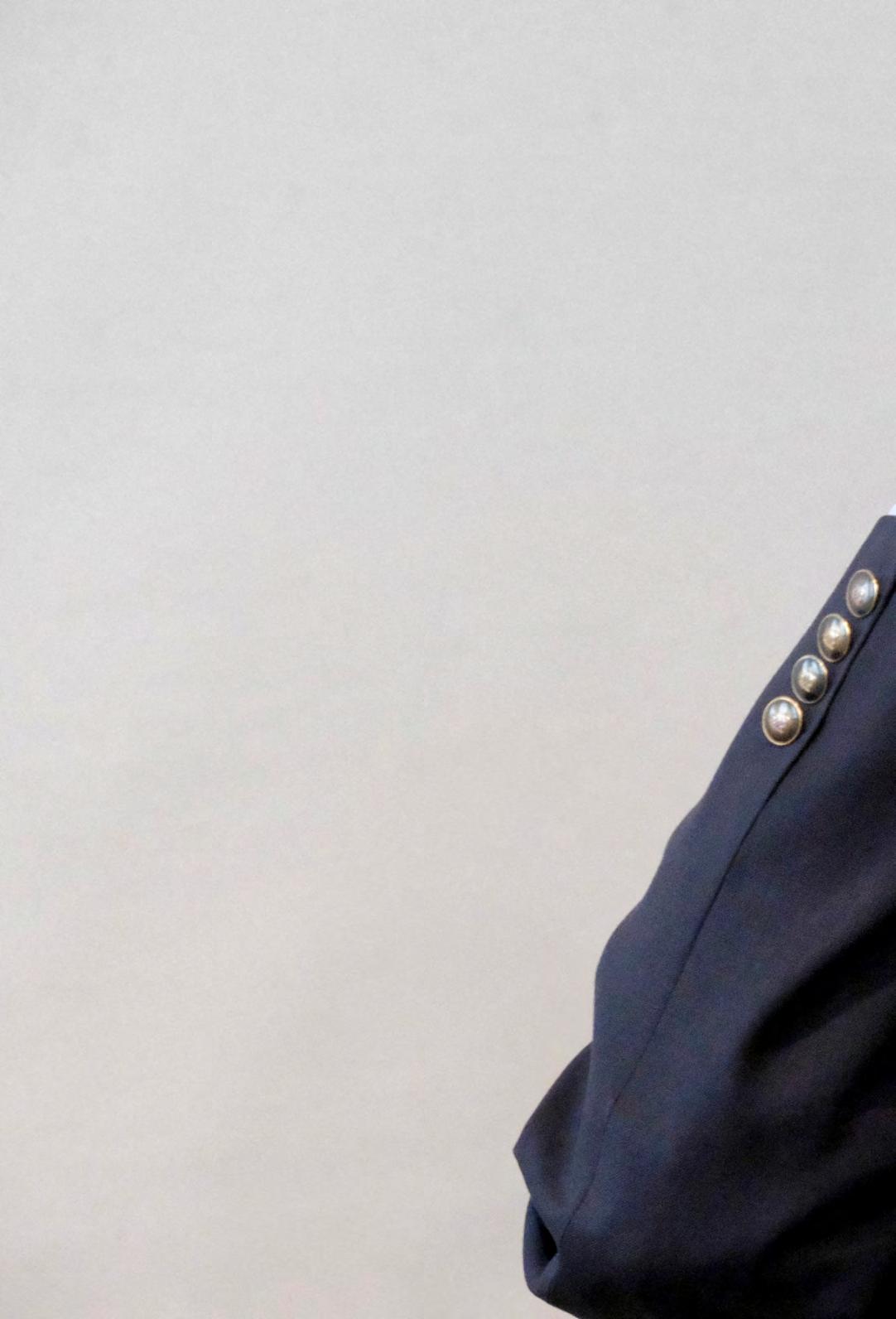
DAVID WEBB: MASTER OF ENIGMAS
Not surprisingly, David Webb’s farewell Fireside Chat at the FCC’s Main Dining Room and The Verandah was sold out less than an hour after registration opened. The event then had to be expanded to the Main Bar & Lounge and Bert’s to accommodate the number of people eager to hear Webb speak (albeit via livestream), with a long waiting list of disappointed would-be attendees relegated to watching the livestream from their devices somewhere outside the FCC’s premises. Following an introduction by FCC President Lee Williamson, the chat began with Philip Bowring as moderator.
By Helena Hu Photo by Tommy WANG / AFP
The smartest man in the Main Dining Room at the FCC on 12 May, 2025 managed to summarise his almost 35 years in Hong Kong and answer questions with Spocklike precision and a dash of humour. It was apparent during the discussion that Webb continues to be laser focused on improving corporate and economic governance and Hong Kong’s future. In fact, on 1 May, 2025, he made all datasets on his website free for download, in the hope that interested parties will carry on his work, in whole or in part.
Webb’s prodigious ability to create wealth was sparked at the age of 13 when he began programming games in BASIC. By the time he was a maths nerd studying at Oxford, he was receiving royalties for having authored computer programming books and programmed computer games. Webb was an early investor in the stock market and remembers reading the Financial Times in the junior common room at Oxford, cycling to the local Barclays Bank where personnel then telephoned his stock orders to London, as this was an era when there was no internet, let alone fax machines.
Following his graduation, Webb worked as an investment banker in London and then began his Hong Kong story in 1991 with Barclays de Zoete Wedd (Asia) Limited. Following successful stints at Barclays and Wheelock and Company, which helped him along the road to becoming independently wealthy, Webb transformed himself into a “one-man NGO” with the launch of webb-site.com in 1998.
Webb was neither apologetic nor boastful about being independently wealthy - rather, it was this wealth that logically paved the way for him to become Hong Kong’s most ardent (if not only) full-time, corporate governance activist investor. Since its inception, the website has been free and is chock-ablock with corporate governance-related data, a smattering of trivia (e.g., the birthdays of famous people are posted every day), as well as Webb’s own musings and (sometimes explosive) extensive research findings for the benefit of Hong Kong investors, academics, business students, and the general public. The data on the website has been populated using Webb’s old fashioned programming skills (giving the site its quaint, “so 1990s” look and feel) but he believes AI could very well be used to update the datasets going forward.
The discussion at the FCC revealed several key themes that have defined Webb’s career and his perspective on Hong Kong’s evolution. Central to his concerns is the city’s

shift away from the laissez-faire economic principles and small government that have defined Hong Kong since 1841 - a shift which began with then-Governor Chris Patten before the Handover. Webb lamented that Hong Kong has moved towards central planning, abandoning the economic differentiation (the opposite of integration) that once made the city very successful. He cited the government’s expenditure on white elephant projects and the disbursement of one-third of Hong Kong’s fiscal reserves during the COVID-19 pandemic as evidence of wasteful spending, including handouts to big businesses that didn’t need the support, instead of to small businesses that were struggling.
Good corporate and economic governance have been the cornerstones of Webb’s activism. His successful campaign for one share, one vote poll voting (as opposed to the former practice of an informal nebulous waving of hands in the room) is just one example of his commitment to the rights of shareholders (particularly minority ones). He criticised the current trend towards weighted voting rights (a system that includes second class shares with lesser voting rights) as a “race to the bottom” that diminishes investor protections. Webb highlighted the absence of a class action system in Hong Kong as a critical weakness in its corporate governance framework, noting that this deficiency leads investors to pay less for stocks due to the higher risk of owning them. He drew parallels with London, which has similarly relaxed rules on related party transactions, suggesting a concerning global trend. Again, he sees lowering standards as weakening the market framework and lowering stock valuations, whereas investors will always favour those markets that afford greater shareholder protections and rights.
Tax policy featured prominently in Webb’s critique of Hong Kong’s economic governance. He characterised stamp duty as a “frictional tax” (now scrapped in other regimes) that doesn’t tax profits or capital gains and advocated for its abolition. His criticism extended to “stupid super deductions” made for R&D that merely generate accounting disputes with the Internal Revenue Department rather than genuine innovation. Webb’s perspective consistently favoured reducing government intervention and returning to the “Lion Rock spirit” of dynamism, entrepreneurialism and selfreliance that has historically characterised Hong Kong and its residents.
The discussion took a mildly personal turn as Webb revealed he may be out of options in his five-year battle with an aggressive metastatic cancer, thereby explaining his decision to make the webb-site.com repository publicly available (already fully backed up) and expressing his hope that a statutory body or university might continue his groundbreaking work. This revelation highlighted the urgency behind his efforts to secure a lasting legacy for transparent governance in Hong Kong. But once again, the focus was not on his own health, but on the greater good of Hong Kong.
Aside from his children and family, Webb said that his proudest achievement was exposing what he termed the “Enigma Network” in 2017 on webb-site.com. In that pregenerative AI era, Webb researched over many months and
eventually managed to uncover a complex web of 50 listed companies with opaque financial practices, cross shareholdings and governance failures. The companies within the web held shares in each other’s companies but below the 5% threshold that would require reporting, allowing them to control shareholder voting and expropriate shareholdings by diluting shares and damaging minority shareholders financially. He also highlighted company shares with unrealistic valuations and company ties to the listed brokerages that manipulated the prices of those company shares. The 2017 article on webbsite.com kickstarted a number of significant SFC reforms. Webb noted that as an activist investor, he chose his battles strategically and considers delays (e.g., the Companies Registry delaying the redaction of directors’ complete HKID numbers) as constituting small victories.
Despite his critical assessment of Hong Kong’s current trajectory, Webb maintained cautious optimism about our city’s future. He expressed hope that China will one day abolish currency controls so that Hong Kong can eventually de-peg from the US Dollar and adopt the Renminbi. He believes that China and Hong Kong will gradually become more democratic, suggesting that Hong Kong may currently be at “peak authoritarianism”. His view of central planning as opposed to free markets is that the former eventually leads to economic stagnation, stifling prosperity.
Webb’s parting recommendations for the SAR included addressing Hong Kong monopolies, dis-allowing controlling shareholders from voting for their company’s independent non-executive directors, introducing a class action mechanism in the legal system, extending auditor liability to shareholders (not just to companies) and generally “raising the game, not racing to the bottom”.
Throughout his career, Webb has believed that principled activism towards better corporate governance is more rewarding than merely accumulating wealth – a philosophy that has earned him the moniker “Long Hair of Finance” (referring to Hong Kong politician and social activist Leung Kwok-hung, nicknamed “Long Hair” due to his long locks). However, Webb politely denied the likeness, stating “I’m not a Marxist”, although the moniker has cemented his legacy as Hong Kong’s most principled advocate for transparency, fair markets and economic freedom. Perhaps the passion for good corporate governance and transparency is reminiscent of Long Hair’s passion for protest, but Webb’s stature and demeanour come closer to that of Dr. Spock - coolly intellectual and logical, even when discussing his own demise (and done only in passing).
The respectful and polite standing ovations given to Webb before and after his appearance at the FCC hardly seemed commensurate with his colossal contributions to corporate governance in Hong Kong over the past three decades - yet the applause quietly embodied his essence - calm, low key, modest and to the point. We all hope that David Webb’s life can be prolonged - every extra day that he walks among us, we are privileged to be in the company of our own homegrown legend. Perhaps his most inspiring statement for all of us mere mortals was: “I will die confident that I did my best.” n
ON A MORE PERSONAL NOTE…
The Correspondent was able to get some rare, one-on-one time with David Webb to discuss his views on matters not related to corporate governance. With his characteristic generosity of spirit, he offered profound insights and answered our most burning existential questions. Shortly after our interview, Webb’s name was included in this year’s King’s Birthday Honours list and he received an MBE “For services to Raising Standards of Corporate [and] Economic Governance, particularly in Hong Kong”. The FCC extends its warmest congratulations on this well-deserved recognition.
Renowned for his uncompromising advocacy for corporate and economic governance in Hong Kong, David Webb has always approached life with the analytical precision of a scientist and the generosity of a teacher. Now, as he faces terminal cancer, Webb’s philosophical outlook remains as lucid and evidencedriven as ever, marked by an insistence on reason, a stoic acceptance of mortality, and an enduring commitment to sharing his knowledge.
A rationalist’s view on religion and existence
Webb’s beliefs are firmly rooted in empiricism. It is not surprising that he does not believe in god, citing the absence of scientific proof or evidence for such an entity. To him, religion is a social construct. “There are sensible rules such as, don’t kill, don’t steal,” he says, while noting that these rules are products of social evolution rather than divine decree. Humanity, in his view, is simply the “result of evolutionary processes - complex, remarkable, but not divinely ordained.” If anything, he believes that religion is very much a human fabrication for the purpose of wielding authority and control.
The search for meaning in a vast universe of data
For Webb, the meaning of life is not handed down from above, but is something to be constructed through curiosity, learning, and contribution. His lifelong habit of learning - whether about financial systems or more recently, the intricacies of his own metastasised prostate cancer, reflects his relentless drive to understand the world as it is. Diagnosed in 2020, Webb approached his illness as another field of study, mastering the science behind his prognosis. Now in his fifth year postdiagnosis, he faces death with pragmatic acceptance and preparation. Having generously provided decades of free corporate and economic research on his website, on 1 May, 2025 he released the data and self-developed software in a public repository.
AI and humanity
Webb’s scientific curiosity extends well beyond listed companies and even Earth. Given the sheer scale of the universe - “approximately one septillion stars in the observable universe” - he believes that life probably exists
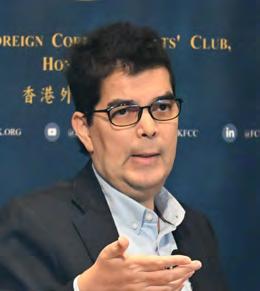
elsewhere. However, he reasons that any civilisation capable of contacting us would almost certainly be more advanced, as mankind has only been sending intentional signals into space since 1974. He speculates that such beings would have experienced evolutionary phases similar to ours, but must have progressed much further than humans, in order to be able to make contact with us.
On the subject of AI, Webb is characteristically clear. He sees the potential for AI to surpass human intelligence as computers become faster and more capable of replicating the human brain. “AI would certainly be a robust successor to humans,” he observes, wryly noting that “AI will not develop cancer.” Yet, he acknowledges the risks posed by “bad actors” and emphasises the role of governments in regulating AI development, bringing the conversation back to his lifelong obsession - governance.
Generosity and happiness
Despite his rationalist outlook, Webb’s generosity is evident in his willingness to share data, insights and experiences. He derives happiness not from abstract spiritual pursuits, but from tangible achievementsprogramming games, writing books, solving corporate governance puzzles, and, above all, spending time with his family.
Facing death
As he contemplates the end of his life, Webb remains stoic, with a calm informed by knowledge and reason. His legacy is not only in the reforms he championed and the immense amount of invaluable data that he has made public, but in his unwavering commitment to evidence, learning, and the betterment of society.
In a world often clouded by superstition and dogma, David Webb’s clarity of thought stands as a testament to the power of reason and to the satisfaction that comes from a life lived in pursuit of learning and sharing for the common good.
Yet this rationalist has chosen John Lennon’s Imagine as a song suitable for his funeral - ultimately revealing that even rationalists do dream.
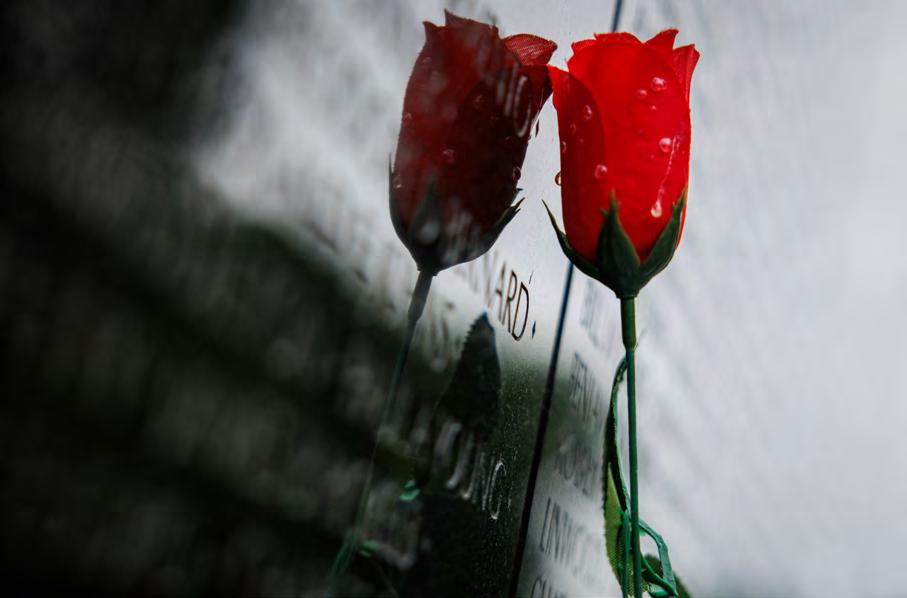
WHISPERS OF SAIGON
By John Batten
Apoignant time for many in the south and known as Black April or Tháng Tư Đen, the 50th anniversary of the Fall of Saigon – 30 April, 1975 – was celebrated with spectacular parades and fireworks celebrations in Ho Chi Minh City (Saigon). Meanwhile in Hong Kong, Saigon has always had a presence, physically and in the city’s psyche. The FCC’s reputation as the world’s most famous press club was cemented during the Cold War as a haunt for journalists and news agencies covering the Vietnam War. Closely aligned were the China watchers debating the merit of rumours during the Cultural Revolution. Later, waves of Vietnamese refugees sought escape through Hong Kong.
Hong Kong film director Ann Hui On-wah made three films about the experiences of Vietnamese illegal immigrants. In her landmark Boat People (1982), she chronicled the persecution experienced by those living in South Vietnam after the Fall of Saigon, showing the conditions that led many to flee Vietnam.
Since Black April, I’ve looked around Hong Kong discovering Saigon in the city. It’s here in pockets. Of course, if you live in or visit Sai Kung, then you are in 西貢, the same Chinese characters as Saigon.
Tai Kok Tsui has its streets named after trees, and a
small locale in Yau Ma Tei and Jordan has streets named after cities: Shanghai, Canton, Nanking, Ning Po – and, Saigon Street bisects the two districts. The area retains, despite development, traditional restaurants, pawn shops, repair places, street stalls, fruit vendors, all types of Nepalese businesses and the overflow of Temple Street’s market vibrancy. I hoped to find a Vietnamese restaurant or a pho noodle-shop on Saigon Street, but there aren’t any. However, the Yau Tsim Mong Multicultural Activity Centre, mid-point on Saigon Street, did have “Vietnamese Fruit Holders” for sale, small ceramic and woven baskets that can also hold keys, we are helpfully advised.
If you walk to the Jordan end of Saigon Street and arrive at Ferry Street, you are close to Tim Kee French Sandwiches (30 Man Yuen Street, Jordan). “The best Vietnamese bahn mi in Hong Kong,” a customer told me as I entered the small holein-the wall shop that has been serving traditional baguette, pâté and pickled salad for 25 years – all with a hint of pepper hotness. He told me he had driven from Sai Kung just for the baguette; I made the obvious joke: “You drove all the way from Saigon for a Vietnamese sandwich!”
At the other end of Saigon Street, near Diocesan Girls’ School, I walked the staircase to the top of an old tong lau ,
A rose left by a visitor leans against the names etched into the wall of the Vietnam Veterans Memorial on Memorial Day on 26 May, 2025 in Washington, DC.

a walk-up terrace building, built in the late 1950s. On top, there were the ruined outlines of rooftop flats and a food factory, with the leftover rusty skeleton of supports for a chimney. With a long view down Saigon Street, the rooftop is now devoted to clotheslines and lots of chairs for the occasional BBQ. A friend of mine, Rinnie, her mother and sister, Chinese Cambodians, had lived atop similar in the 1990s.
On 17 April, 1975 the Khmer Rouge entered Phnom Penh, ending the Cambodian civil war. The city’s populace was forced from their work, homes, and businesses “into the countryside” and opposition troops were rounded up and executed. The madness of the Khmer Rouge regime saw millions die of starvation, illness and violence in the following years. Rinnie and her family escaped, like many others, by walking from Phnom Penh to Saigon. Still a young girl, her overriding memory is of dead bodies lining the sides of the road. Her scattered family, a classic Southeast Asian Chinese diaspora family, operated small businesses in Yangon, Saigon and Hong Kong, while also having relatives in Guangzhou. Eventually, they were able to resettle through family reunion in Hong Kong, living for a time in a small Causeway Bay rooftop flat, not much different from this Saigon Street rooftop.
Rinnie walked along Route 1, the main road from Saigon to Phnom Penh. On the same road on 8 June, 1972, Phan Thi Kim Phuc, her brother, grandmother, and cousins, fled napalm fire-bombing by the South Vietnamese air force
trying to disperse Viet Cong and North Vietnamese troops from Trang Bang village, 60 kilometres from Saigon.
Caught in the bombing and badly burnt, Kim Phuc had taken off her burning clothes and ran with her family down the road as the village burned behind. A group of photographers and TV cameramen were ahead of the children, also on the road. The iconic photograph ‘The Terror of War’ or ‘Napalm Girl’ was taken by one of them. Published the following day in The New York Times and the LA Times among others, it was subsequently republished around the world. The Associated Press (AP) photographer Huynh Cong ‘Nick’ Ut won the Pulitzer Prize in 1973 and a World Press Photo award for the photograph.
Shown at the 2025 Sundance Film Festival, an investigative documentary film, The Stringer, directed by Bao Nguyen, questioned who took the photograph. Carl Robinson was the photo editor working in the AP Saigon bureau office at the time and alleges that he was told by Horst Faas, AP’s head of photography, to change the named attribution of the photograph from a stringer to the AP photographer Nick Ut. That stringer is identified in the film as Nguyen Thanh Nghe, who was assisting an NBC TV crew as a driver on the day, and says he also shot a roll of film and delivered it to the AP bureau office. Finally, the film analyses the relative physical positions of all the photographers working on that day from the available evidence, claiming that Ut was not in the right position to have taken the photograph.
In early May 2025, Associated Press released its own
Rooftop view down Saigon Street, Yau Ma Tei, Hong Kong
IMAGE: JOHN BATTEN
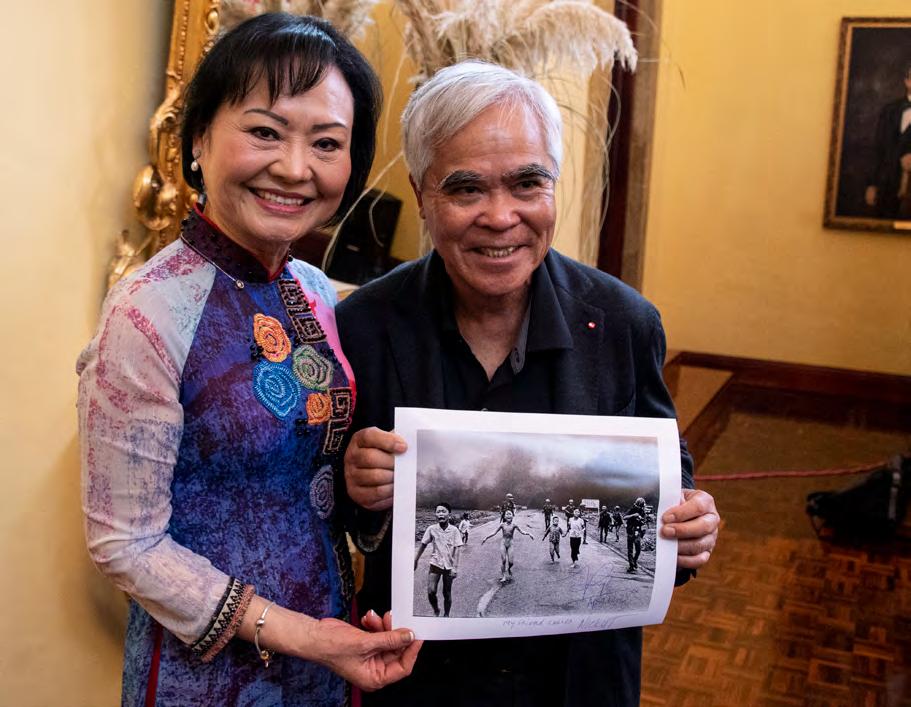
comprehensive analysis. In summary, it maintains the attribution of Ut as author of the photograph, but concedes there is doubt, stating that “probably Nick Ut took the photograph.”
Correspondent Member Laura Westbrook and I have made a podcast, edited by Jarrod Watt, available on the FCC website, discussing the photograph and the complexities of the film’s allegations. We all await to see The Stringer, but the film’s producers have not released it yet for general distribution.
Ut’s signed ‘Napalm Girl’ photograph can be seen in the FCC Bunker. It hangs alongside other distinguished Vietnam War photographs. Faas was AP’s chief photographer for Southeast Asia based in Saigon for over 10 years and two of his most harrowing, brutal photographs are on the wall: a drawn dagger as a mud-covered farmer is threatened with death for allegedly giving false information; and, above it hangs a photograph of a road covered with bodies. Likewise, Hugh Van Es’ battlefield photograph depicts the dire conditions on the infamous Hamburger Hill.
In the 1960s, LIFE magazine had a shelf-life much longer than its week of publication: for months, past copies would sit in doctors’ and dentists’ waiting rooms, it was ubiquitous
in barber shops; copies were seen in school classrooms and then cut and pasted in art rooms. Read by millions around the world, LIFE ’s long photo essays and text were highly influential – especially about the Vietnam War.
Also in the Bunker are photographs by Larry Burrows from his long photo essay One Ride with Yankee Papa 13 Burrows spent a day, 31 March, 1965, with Yankee Papa 13, on a U.S. helicopter with its crew on a combat operation to support soldiers on the ground under attack from the Viet Cong. Published a fortnight later in LIFE , the visceral and sudden violence of the mission resulted in one killed and another crew member seriously wounded. Burrows was in the middle of the action and his photographs, of the blood, fear, anguish, and the crew’s emotional return to base, were published – shocking and uncensored – for LIFE ’s readership.
In contrast, American-Vietnamese photographer AnMy Lê’s photobook Small Wars (2005) shows two aspects of the aftermath of the war. In beautiful large-format prints republished in May this year as a 20th anniversary edition, she depicts a calm, but battle-affected Vietnam, both in the countryside and cities. In the second section of her book, she photographs returned American veterans re-enacting
Vietnam War survivor Phan Thi Kim Phuc (L), also known as the “Napalm Girl”, poses with photojournalist Nick Ut holding his 1972 Pulitzer Prize and World Press Photo awardwinning photograph during the presentation of the Spanish edition of her book at the Ministry of Foreign Affairs and Worship in San José on 12 April, 2023
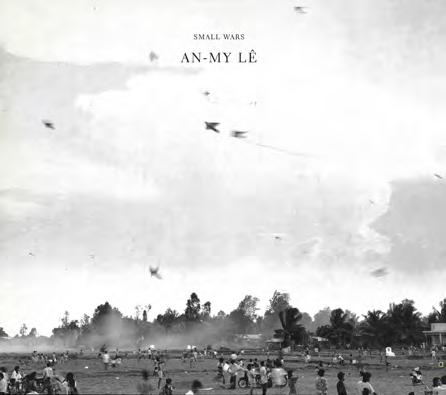
the violence of Vietnam War battles in the U.S., using authentic weapons, vehicles, uniforms, flares, lighting, and battle locations similar to those found in Vietnam. In some photographs, the photographer has agreed to dress and act as a Viet Cong guerilla, replicating their infiltration among the wet forests of the Mekong Delta.
Found around Vietnam’s many rivers and forest areas, the distinctive green Chinese Water Dragon is, despite its name, not common in China. A pair, however, can be seen in the Tuen Mun Park Reptile House and reportedly is feral in Hong Kong’s country parks. Poached in Vietnam for its meat and as a popular pet for the illegal pet trade, the water dragon and its eggs are also added to Vietnamese rice wine, supposedly for extra potency.
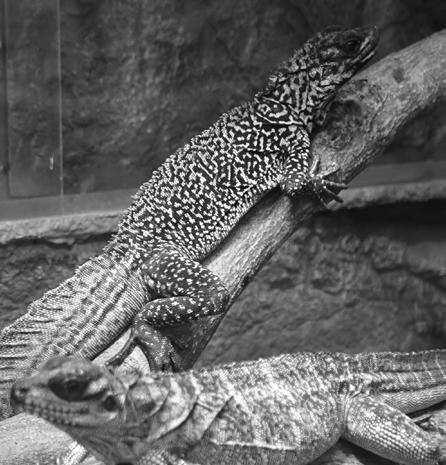
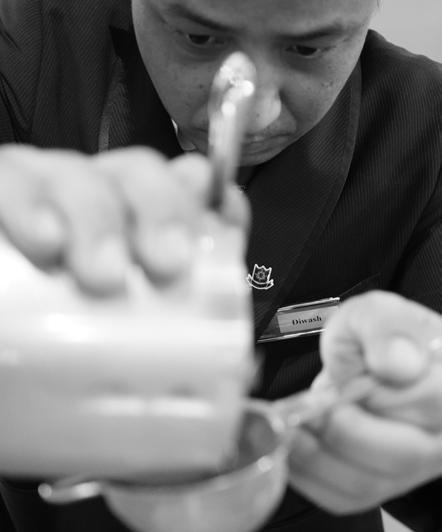
I can’t imagine drinking lizard-infused rice wine, but a regular Reuters correspondent advised me one night that Diwash Gurung, Bert’s Bar Supervisor, made a “mean cocktail”. I asked Gurung at very short notice to mix a “Vietnamese cocktail”. His Vietnam Lemonade is a refreshing summer lemonade mocktail – and adding gin or vodka gives it bite.
So….Cheers! “Một hai ba, dô!” – “One, two, three, go!” n
Vietnam Lemonade
1 pc lemongrass stalk
5 pcs Kaffir lime leaves
15 ml fresh lime juice
10 ml sugar syrup
1 drop fish sauce
1 cinnamon stick to garnish
Add chopped lemongrass stalk and lime leaves into a cocktail shaker, give it a good muddle. Add all the other ingredients and fill with ice and shake hard. Strain into a highball glass and top up with soda. Add vodka or gin to your liking for a cocktail.
Links:
Associated Press ‘Napalm Girl’ report, May 2025: TerrorOfWarReportUpdate_May2025.pdf
FCC Podcast on the ‘Napalm Girl’ controversy https://open.spotify.com/episode/5X62zV2UaU92fCoU7udb1p
Cover of An-My Lê’s photobook Small Wars (2005)
Bert’s Bar Supervisor Diwash Gurung prepares Vietnam Lemonade
IMAGE: JOHN BATTEN
A Chinese Water Dragon at Tuen Mun Park Reptile House
IMAGE: JOHN BATTEN
POLO BOURIEAU: ON THE CUTTING EDGE
At a recent event at the FCC, sculptor Polo Bourieau spoke passionately about his profession as well as his recently launched first book, entitled ‘Written In Stone’. The book is not just a collection of photographs of his work, but a self-written narrative of Bourieau’s journey as a sculptor, framed around the concept of a hero’s journey. During his FCC talk, he also discussed his focus on integrating sculpture into urban environments, emphasising the importance of art being accessible to the public.
By Ann Tsang
Fresh from a talk and a signing session at the FCC for his first book, the self-penned ‘Written In Stone’ (Hong Kong University Press, 2025), Polo Bourieau is palpably excited about his venture into writing, and so are the audiences he has been addressing while promoting the tome.
‘Written In Stone ’ is essentially an exploration of how large-scale sculpture has the magical ability to transform urban spaces into places of focus and connection where dialogues occur between the sculpture, its surrounding architecture and the community.
In Italian ‘polo’ means axe or axis, around which a sculpture is born from its material. This name was given to the artist by the Italian quarrymen of Carrara, a place that is of almighty importance to sculptors, past and present, and to further tell the artist’s story, we must first journey to this area which has borne witness to the advent of an industry that has remained virtually unchanged since a certain Snr. Buonarroti hauled his first piece of pure white marble out of the Carrara mountains in the late Renaissance.
The Versilia is a stunning stretch of the Apuan Alps. A 40-minute drive from Florence, the backdrop of the glistening white peaks reaches almost 1,000 metres above sea level, but this white is not snow, nor ice, and you certainly can’t ski here. These are peaks of pure white Carrara marble – an amazing feat of nature, formed over millions of years of volcanic activity, tectonic plate movement and changes of temperature.
You would think that after more than 1,000 years of quarrying (the first exploiters were the Romans) to supply the world with the most beautiful of nature’s building materials - the pure white cristalline statuare marble - there would be nothing left.
Conservationists declare that continually hacking away at the mountains is affecting the environment, yet it continues, 24 hours a day, 7 days a week, 52 weeks a year. But whilst the majority of the marble is used to grace buildings as cladding
and flooring, the best is saved for the most primitive of art forms - sculpture.
Ancient methods of cutting this stone out of the heart of the mountains were somewhat more labour intensive than they are today, but the principle has not changed very much. The stone still needs to be carefully selected out of the mountain. It is then cut out in sections or blocks (the usual size of which is bigger than a regular car and each weighs around 15 tons). These blocks are then hoisted onto heavy goods vehicles, which then zig-zag down specially made tracks, where they are then cut into smaller blocks, and taken to ‘block parks’ on the side of the SS1 Aurelia (once the longest and one of the oldest roads in the world; built by Emperor Marcus Aurelius).
This is where the sculptors then come to choose their blocks, but rare are the artists who climb up to the quarry to find their own marble, because rare are the quarrymen who permit them to do it, preferring to extract the stone themselves without interference.
It is said Michelangelo would choose his slabs of marble at dawn. As the sun rose behind the blocks of marble, they would become quite translucent, and so he could check to see if there were any undesirable veins, cracks or blemishes concealed inside.
While this all sounds wonderfully romantic, it can still today be hit or miss if a block is hiding something inside or not, and an unskilled sculptor can lose weeks of precious time if he discovers a crack when half way through his creation.
Carrara, and its surrounding towns with their rough acquired culture of quarrymen and artisans, is a sculptor’s mecca, forming a 30 kilometre-long treasure chest, enticing unfailingly impressive generations of young sculptors from all over the world, who come to this little slice of marble heaven in Northern Tuscany to follow in the footsteps of those who came before them.
Henry Moore was there in the 1950s, and was mainly
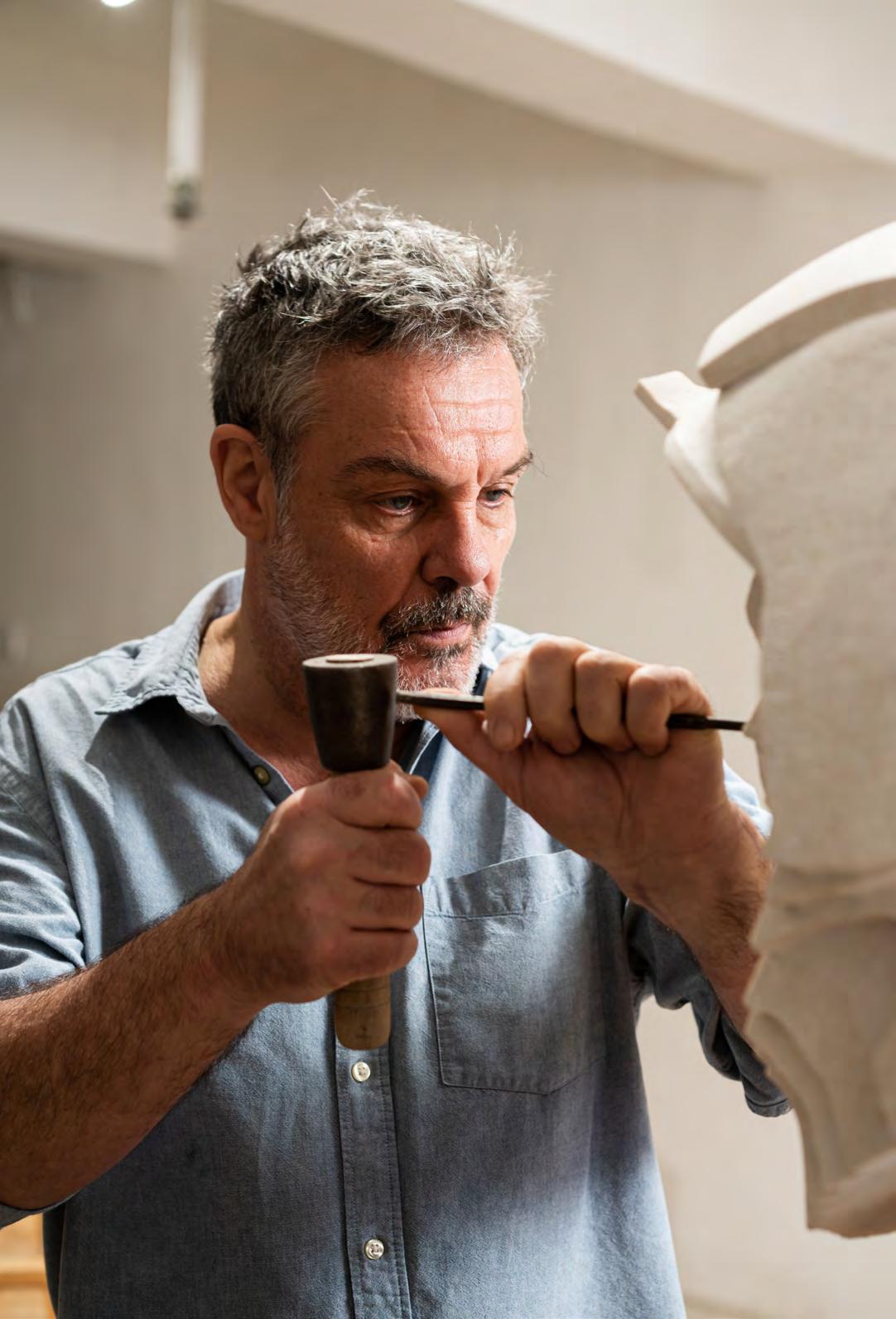
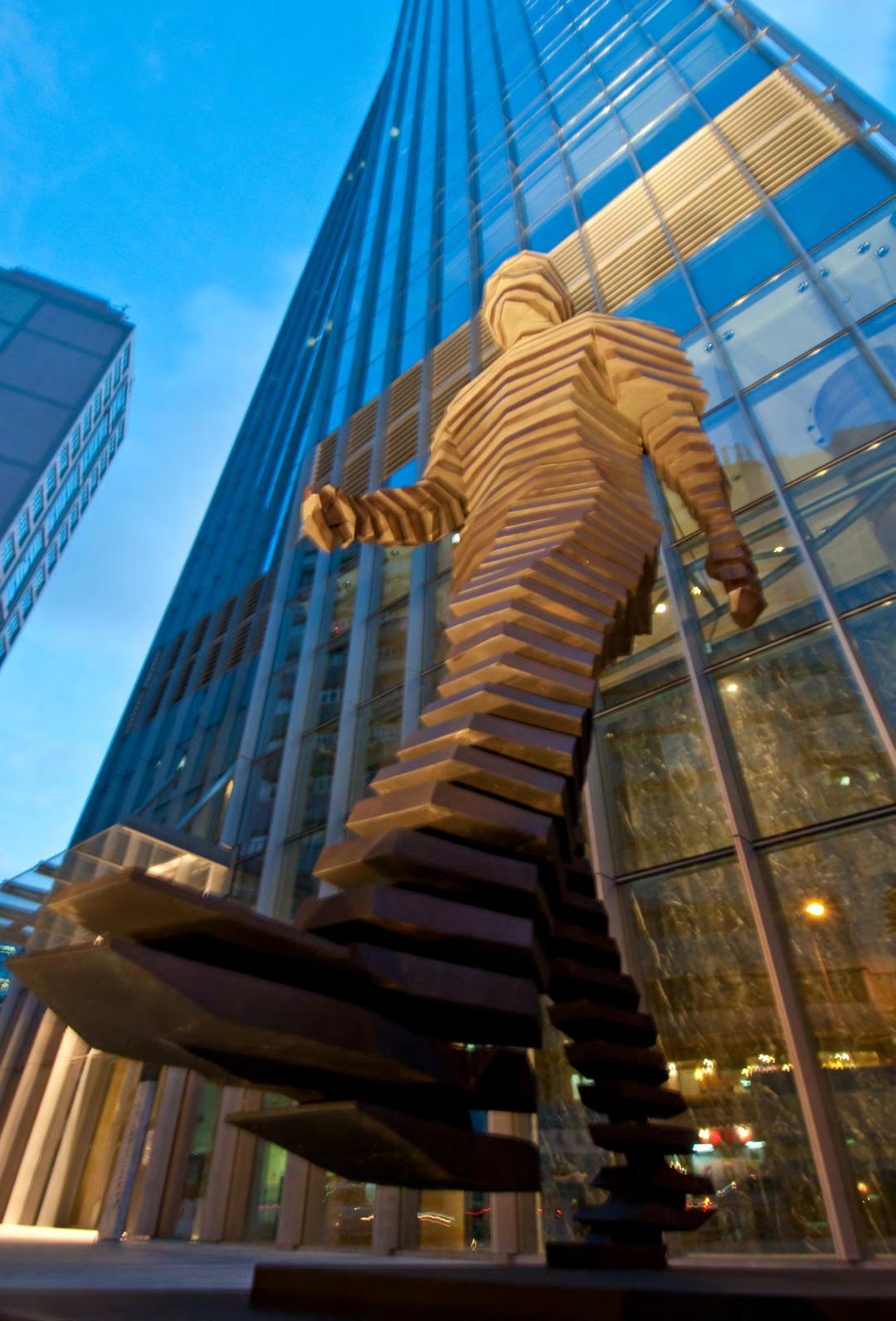
IMAGE: WILLIAM FURNISS
‘Walking East’, 2009. 500 x 300 x 180 cm. Cast iron, powder-coated steel. Landmark East,. Kwun Tong, Hong Kong
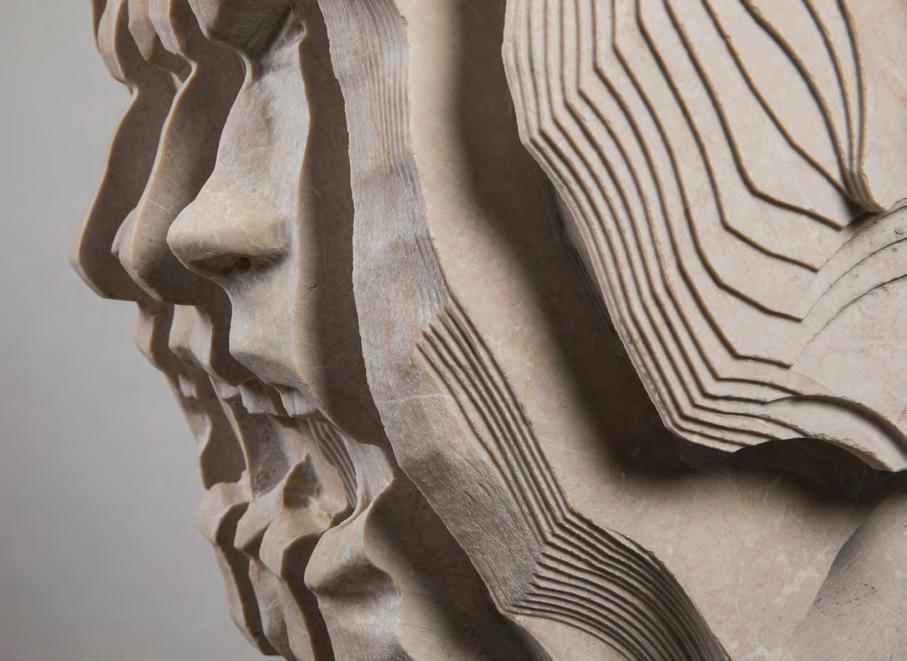
responsible for resurrecting a failing religious sculpture industry whose predominant client was The Vatican. Moore introduced his design for a contemporary abstract sculpture and was almost laughed out of town, but with a little persuasion towards the artisans, he helped breathe new life into the studios and workshops.
Almost all of the great sculptors of the second half of the 20th Century made their pieces in Pietrasanta: Fernando Botero, Anish Kapoor, Mark Quinn, Jeff Koons, Damien Hirst, and others. The list of masters reads like a who’s who of sculpture.
And it is a new generation of sculptors, the Fred Flintstones of the 21st century, in today’s high tech art market, who are still pursuing the most primal of urges to dig slabs of stone out of the mountains and carve them into beautiful sculptures. Polo Bourieau is one of them.
If one were to dissect Bourieau’s career trajectory, to many it may appear that his resume was written the wrong way around.
Following his training with the exclusive Compagnons, the French stone masonry company, Bourieau cut his teeth (and hands) restoring cathedrals and monuments, the most notable of which was the stonework of the Napoleon Court of The Louvre – no mean feat for a 21-year-old who when he was a young art student in Nantes in 1983, an old stone mason master challenged him to cut a cube out of a boulder
of the local limestone with only an axe.
“My hands, at the time familiar only with pencils and models, bled every day from wielding the five kilo ‘taillant ’ (axe) against the rock,” he recalls. “The workshop was basically just a roof on sticks and looked like an abandoned temple, with bush-hammered granite mantelpieces, roughhewn chiselled marble torsos, sketched out composite limestone renderings, and an hypnotic greyish-yellow, gold veined polished tombstone that I never encountered again.”
The cube never became, but Bourieau has not stopped sculpting since.
He created the studio M.A.D. in Turin in 1998, specifically to explore the frontier that exists between sculpture and architecture.
As the Nineties slipped awkwardly into the Noughties, art in Asia exploded, led by Chinese contemporary painters. Galleries opened, art fairs flourished, and moreover, public art became “a thing”.
It is here that our protagonist enters again.
More than 20 years ago Bourieau decided to move to Italy to perfect his marble sculpture techniques, and in the same year, upon his first commission by a prolific corporate Hong Kong-based art curator, Bourieau landed in the SAR, to meet the aforementioned demand for public art – a concept that had always been present in his native Europe – be it through town squares, city landmarks, or in other realms. Thus
‘Emicrania’ (detail) 2020 78 x 46 x 30 cm. Botticino marble. Private collection, Hong Kong

‘Alice’ 2003 350 x 120 x 100 cm. White Carrara marble. Private collection, Hong Kong
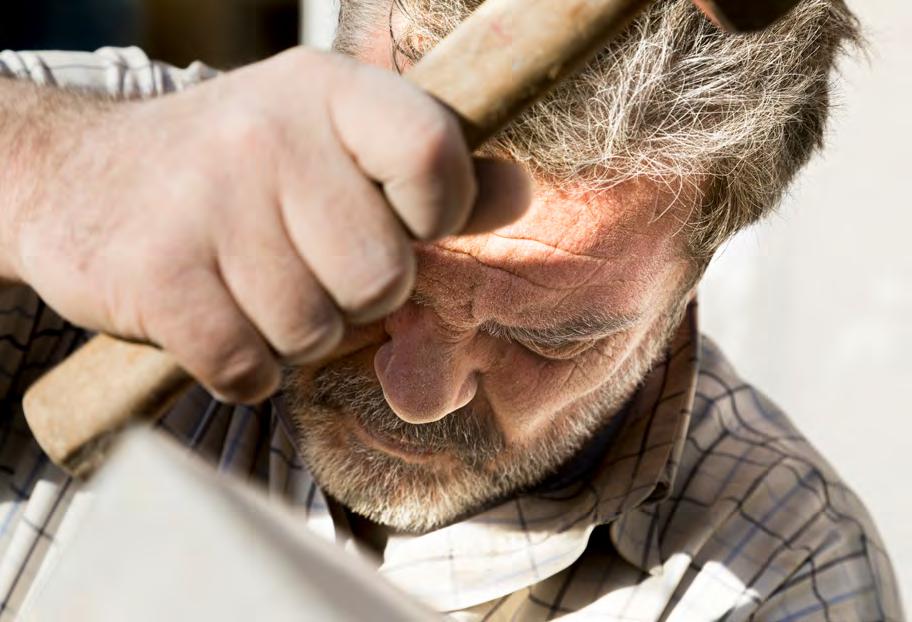
started the next phase of his career, which has since brought him to work on monumental public art projects in Mainland China and Hong Kong.
While he has modern-day technology to assist with the execution of the huge, monumental sculptures he creates, the techniques themselves have remained virtually unchanged for hundreds of years. Each block of stone is selected for its suitability in size and shape for the sculpture it is intended for, and Bourieau prefers to go direct to the quarry for his blocks to be custom cut, rather than to the block parks. He then shapes or “rough cuts” the block to the general form it will eventually take.
The detail is then carved, using angle-grinders, hammers, and chisels to chip away at the many layers and levels of stone. It is noisy, dirty, messy, and physically exhausting, yet there is something quite exhilarating about watching an artist of this calibre at work.
As in most realms of life today, technology is now playing a role in some of Bourieau’s work. A ‘robot’, which he fondly calls ‘Kuka’, is “just another addition to my toolbox”, he laughs. “I programme his path and then I discover; it’s just like working with a chisel – between the mind and the piece of work, there is always some form of tool that will make it happen. Many artists will deny that they use such a tool, and the general assumption is that working with a robot makes the whole process easier, which is absolutely not the case. Without me communicating with it, it can’t do anything, and when I tell it what to do, it offers me new textures – those that I cannot create with a chisel or an axe. It’s a new way to
sculpt and I believe that I am one of the very few artists who have acknowledged and implemented this technique. It also provides a completely different method of understanding the material that I am working with.”
In the robotic realm, Bourieau collaborates with his friend and fellow sculptor Sebastiano Stagetti of Studio Marble Stagetti, the last remaining workshop actually located within the walls of Pietrasanta, as many others have relocated to industrial estates nearby.
Stagetti is the fourth generation of a sculpting family, and he and Bourieau have worked closely to develop their robotic techniques in a mutual pursuit of taking them to the highest level. Together they are pushing the boundaries, to the extreme point that they have already destroyed two robots.
“I have learned a lot myself since the bloody axe. And during the years, I’ve developed my own devices and conceptual mechanisms to be added into my inherited toolbox,” explains Bourieau. “Diamond disks, tungsten carbide burrs and conical steel drill bits are now mounted on a robot’s arm, but under my command, they still reveal fragile and enigmatic standing figures, strong and sensual torsos and expressive heads.”
Bourieau affectionately refers to Marco Polo as “having written the first Lonely Planet Guide”. But the connection between Marco Polo’s origins in Venice and his journeys through Asia are not dissimilar to Bourieau’s journey through the medium of his art, and he is well on his way to leaving his mark on this planet, which may inspire us to not feel so lonely again when in the presence of his work. n
THE DEVIANT AESTHETE
From the 1940s through to her death at the age of 94, photographer Lillian Bassman’s images broke boundaries, captivated the fashion world, and made her a truly creative force of the 20th and 21st centuries. Using unconventional techniques in the darkroom to create unique, mysterious and moody photographs predominantly for Harper’s Bazaar and the major French couture houses in the 1940s and ’50s, Bassman was a woman way ahead of her time.
By Ann Tsang Images: Lillian Bassman
Once you establish something that you love you find that the business world stops producing it!” veteran photographer Lillian Bassman said in what would be her last interview. “You have to find a new way of expressing yourself.”
Expressing herself is something that Bassman did for more than five decades, and few people have ever surpassed her in her art. “She is as important to fashion photography as Richard Avedon and Irving Penn,” said gallerist Peter Fetterman in a commentary in The New York Times, “she just didn’t get the recognition that they got.”
Born in 1917 in Brooklyn, Lillian Bassman was a free spirit right from the start. In the 1930s, she danced with Martha Graham, posed nude at the Art Students League for 50 cents an hour, got arrested at a W.P.A. sit-down and, with her boyfriend, Paul Himmel, “spent weekends walking to the Metropolitan Museum which was free. There were concerts... that’s when I fell in love with fashion and painting, the early painters of the 15th and 16th centuries. The emphasis was on gesture and fashion and fabrics. That was our education, our cultural life.”
That cultural life was intertwined with a romantic life and Bassman and Himmel were married in 1935, when Bassman was 18 years old. Both children of Russian Jews, they first met in the summer of 1923 on Coney Island, where Bassman’s mother worked as a waitress at a vegetarian boarding house owned by Himmel’s parents. “I first met Paul when I was six years old,” recalled Bassman. “I didn’t see him for 10 years after that, and then we met again when I was 15. We lived together at 16, and I have now been with him my whole life.”
Following their marriage, Himmel and Bassman both enrolled at the New School, under the legendary art director Alexey Brodovitch. Himmel’s first fashion shots were published in Junior Bazaar, and soon he was one of the few photographers working for both Vogue and Bazaar simultaneously. Meanwhile Bassman landed an internship at Bazaar, assisting Brodovich and eventually becoming his co-art director at Junior Bazaar. She was somehow fortunate
enough to be located on the same floor as photographer George Hoyningen-Huene, and as she became more and more uninspired by the images that she was being presented with, she decided to take action. “I was so tired of all those static pictures and everything being so sharp and clear. There was no romance as far as I was concerned, so I went into Hoyningen-Huene’s darkroom, and using his negatives I started to experiment with making the photographs softer... having the edges disappear, to make the focus what I wanted.”
A bold move indeed.
“I took tissue paper and experimented with working with effects. I wanted to take the hardness out of the images, to make them softer, so I made blurred edges and burned in or bleached out other areas of the pictures. It was an experiment to get what I wanted.”
And that was before she became a photographer.
It was Brodovich who encouraged Bassman to finally pick up the camera herself. “I had been art directing for quite some time and the magazine was being taken over by a female merchandiser type who was not of my philosophy. It was becoming too commercial so I quit. I told Brodovich that I had to find a new venue and he said, ‘Why don’t you become a photographer?’, then he gave me my first assignment.”
It was 1947 and a major year for European fashion. When Bazaar sent Richard Avedon to Paris for six weeks to photograph the collections, he offered Bassman the use of his empty studio. “I didn’t know how to handle a camera, but fortunately I had one of his [Avedon’s] assistants at my disposal. I used his equipment and his studio and at the end of two months I landed a great big juicy lingerie account, I think more because I understood movement from my years as a dancer, and I understood models.”
And so began Lillian Bassman’s illustrious career as a fashion photographer.
As one of the leading photographers for Harper’s Bazaar for almost two decades, the errant aesthete completely reinvented fashion photography of the day with her sensual and highly abstract touch. Mysterious and feminine,
“She is as important to fashion photography as Richard Avedon and Irving Penn, she just didn’t get the recognition that they got.”
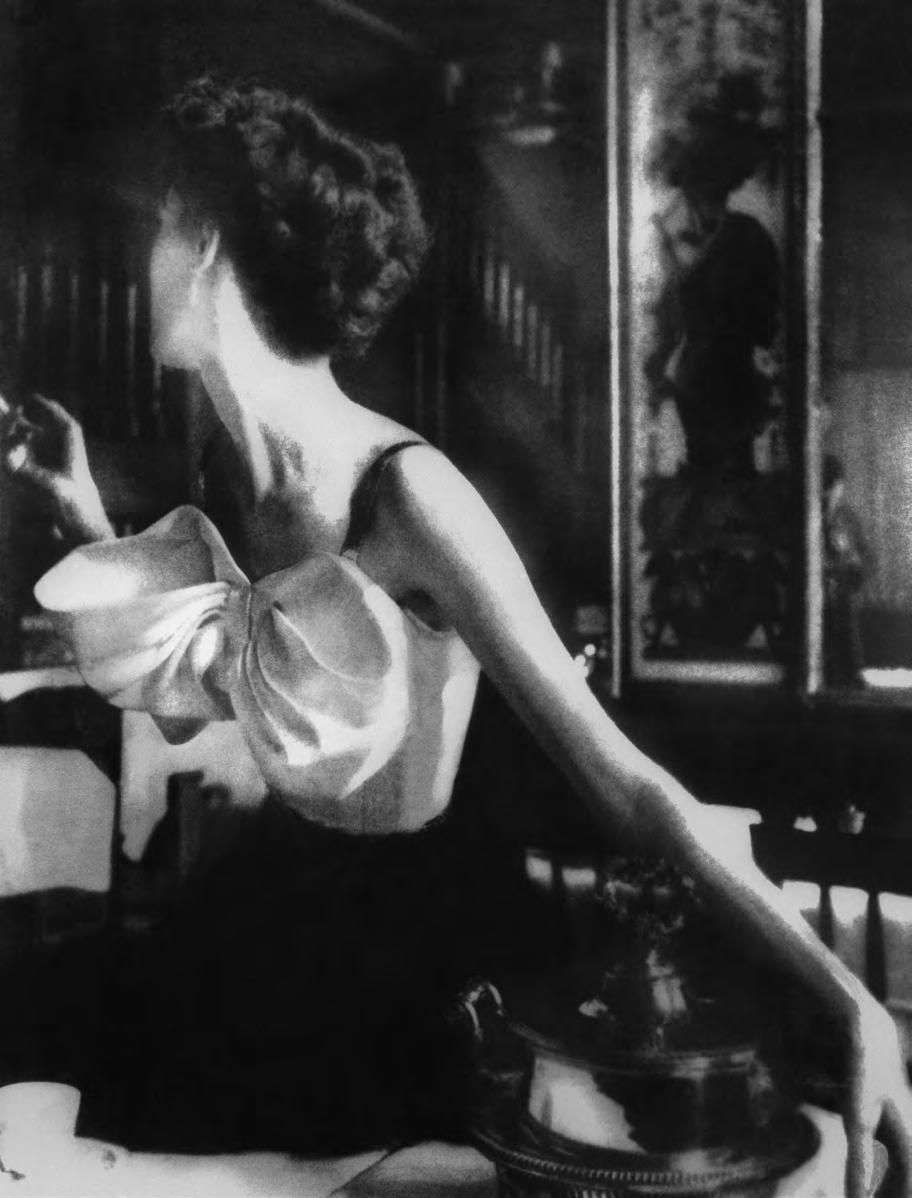
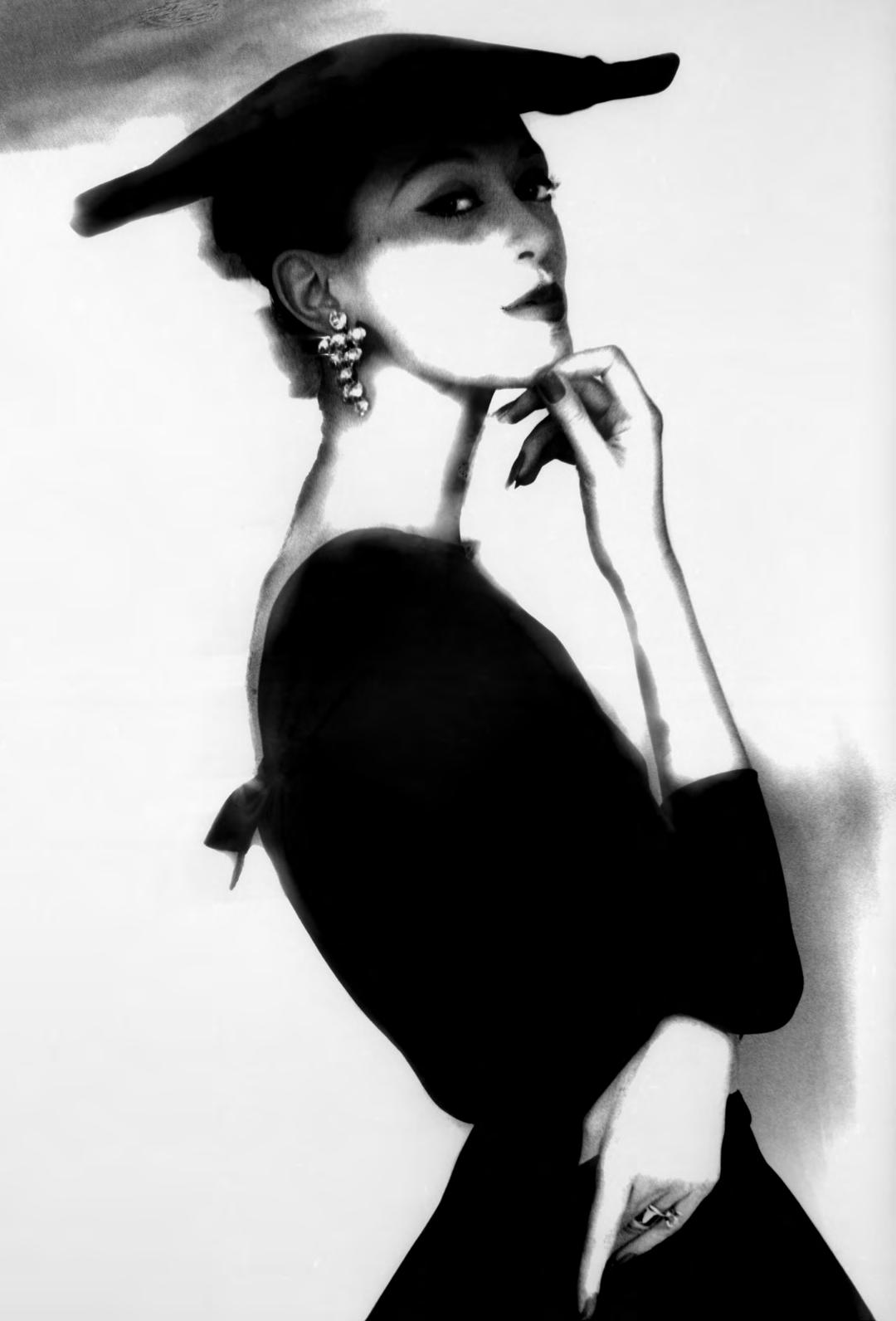

romantic and elegant, her black-and-white images were both alluring and cutting-edge. She experimented with tissue, gauze, bleach and paintbrushes, her fingers, her eyes and her temperament to give her work a moody, diffused look. Curves, angles, and the high-contrast facial features of the models were prominent in Bassman’s work, and the way the shapes of their bodies and garments intermingle takes precedence over the models themselves. “The darkroom was my baby,” she said. ”That is where I really lived and thrived. That’s where my feelings for photography happened.”
By the 1970s, Bassman’s interest in pure form began to clash with fashion’s constantly changing aesthetic. Her increasing disenchantment led her to abandon fashion photography in favour of her own more artistic projects, and in a bold attempt to free herself creatively from the past, she threw out 40 years of negatives and prints - her life’s work. In a November 2005 interview with The New York Times she said: ‘’I was no longer the star. The model was the star. The hairdresser was the star. The makeup man was the star. They were taking over the sittings, and I was going crazy. I sat on the sidelines and watched this performance going on and got so bored. By the time I got to photograph, I was exhausted.’’ In 1969, Himmel had also become completely disenchanted with his art and gave it up to become a psychotherapist.
Bassman retired from editorial and commercial work to
focus on her art projects two years after Himmel had traded in his camera for a shrink’s couch. She even abandoned blackand-white photography temporarily and experimented with colour photographs of fruit and vegetables that were six feet tall, and dabbled in silk screening.
Although Bassman dipped in and out of projects, the ‘90s saw her return to the world of fashion photography. In 1991, Martin Harrison, a British photography historian, stayed at her home and discovered more than 100 batches of negatives, mainly from the late 1940s and ‘50s. He urged her to make new prints from the negatives and they travelled to exhibitions at museums and galleries around the world. In 1996, at the age of 80, she was hired by Neiman-Marcus to shoot a 24-page advertising campaign, which was carried by Harper’s Bazaar, the same year that The New York Times Magazine asked her to photograph the couture collections in Paris.
“I’m struggling to find a new way of doing what I do. I’ve become quite excited about using the computer and I’ve actually done quite a number of prints now that I’m happy with,” she said. “If you live long enough, then you find that you really have to change with the techniques. Things that I have used for years have disappeared. I can no longer go into the darkroom because the paper and the chemicals that I once used are no longer in existence.” n
FOCUS AT THE FRONTLINE 2024: THE STORIES BEHIND THE LENS

The Hong Kong Press Photographers Association’s annual news photo competition, Focus at the Frontline 2024, has unveiled its winners, celebrating the complexity and significance of photojournalism. This year’s judging, held on 10 May, brought 836 photos, 56 photo stories, and 75 entries to the table, submitted by both professional photojournalists and students.
The Annual Photo award went to Lin Zhendong of Initium Media for his evocative image of the former Apple Daily building. The judges praised the photo for its historical resonance, describing it as a “milestone” in documenting the evolution of the media industry. The abandoned office space stands as a poignant symbol of change, offering viewers an opportunity to interpret its layered meanings. “This photo challenges traditional hard news photography. It reflects a modern shift, whereby photographers trust the audience’s ability to engage deeply with images,” noted one judge.
In an unprecedented decision, the General News category
left its top three awards vacant. The judges unanimously agreed that this year’s submissions did not meet the standards of prior competitions. Instead, the three highest-scoring works were designated as “Excellent” to commend the efforts of journalists who continue to document the times, despite challenges. The panel encouraged professionals to explore diverse subjects beyond their daily assignments.
The Student Group saw an increase in participants to 13 this year, with works that impressed the judges for their sincere perspectives on society. The panel lauded the students’ creativity and commitment to social issues, expressing optimism for the next generation of photojournalists.
Since its inception in 1993, Focus at the Frontline has stood as Hong Kong’s premier news photography contest, showcasing work that blends historical significance with artistic and journalistic value. Each year, it reinforces the vital role of photojournalists in deepening public engagement with current affairs.
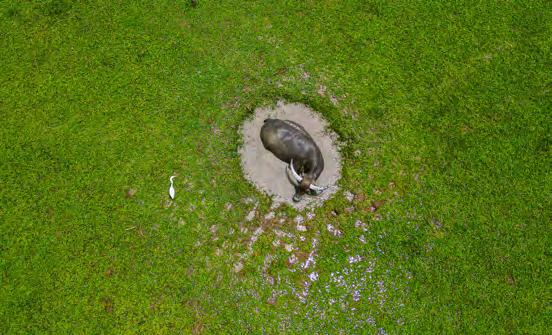
Tsang Kwok Chung, South China Morning Post
Lee Yui Chit Eugene, South China Morning Post
CREDIT: LEE YUI CHIT EUGUENE
CREDIT: TSANG KWOK CHUNG
WOMEN IN WAR: A RETROSPECTIVE BY NICOLE TUNG
Nicole Tung, a Hong Kong-born photojournalist, has built a career documenting some of the world’s most volatile conflicts. From Syria to Iraq, and most recently, Ukraine, Tung’s work is raw, unapologetic and often emotional.
In the Ukraine war, Tung has captured powerful images, not only of combat, but also deeply poignant moments in the lives of ordinary people enduring extraordinary circumstances. Her images chronicle the personal cost of war: families torn apart, cities reduced to rubble, and moments of quiet humanity amid the chaos. “It’s important to document these moments because they are history in the making”, said Tung in an interview. “Photographs allow us to preserve the stories of those who might otherwise be forgotten.”

Tung’s dedication has not gone unnoticed. In 2022, she won the prestigious Robert Capa Gold Medal from the Overseas Press Club of America, an award given for exceptional courage and enterprise in photojournalism. The judges praised her for “her unflinching and empathetic documentation of the human cost of war.”
Her images also earned her the 2022 Columbia Journalism School’s John Chancellor Award for Excellence in Journalism.
Tung, who has worked for publications such as The New York Times, The Wall Street Journal, and TIME, reflects on the emotional toll of her work: “You can’t cover war without being affected. But I try to focus on the humanity in these storiesthe strength and courage of the people I photograph. That’s what keeps me going.”

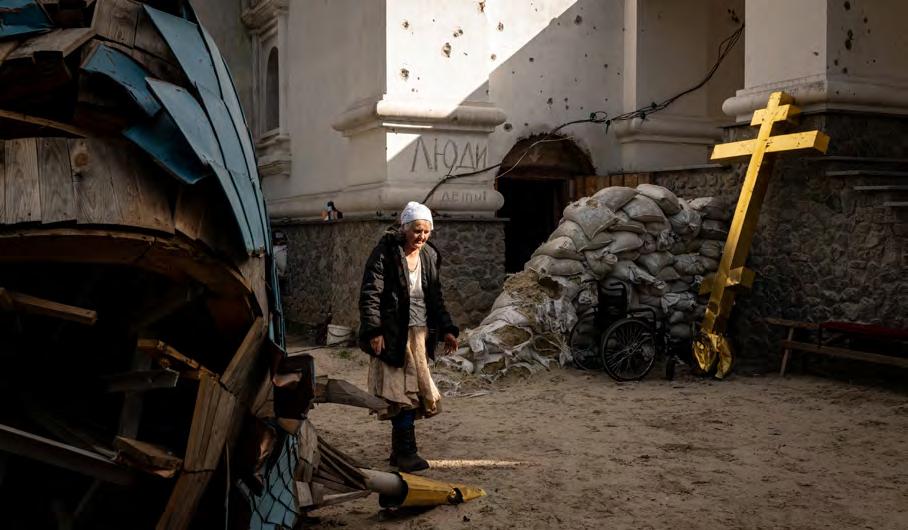
THE LIFE AND TIMES OF THE PARIS METRO
In the world of journalism, there are stories, and then there are stories. The founding of The Paris Metro Magazine in 1976 by three American reporters falls squarely into the latter category - a tale brimming with ambition, eccentricity, and a healthy dose of gall (and Gaul). What began as a whimsical idea in the City of Light became a beloved publication that captured the spirit of Paris, its expats, and its quirks with equal parts wit and wonder. So how did three journalists, armed with little more than typewriters, café tabs, and a stubborn refusal to take“non” for an answer, pull it off?
By Adrienne Raphel
In 1974, Harry Stein and Thomas Moore, young editors who had worked together at New Times, a glossy biweekly in New York, had an idea: let’s start a magazine - in Paris. Moore had recently come into a windfall when one of his articles, about a bank robbery in Brooklyn, became the basis for the film Dog Day Afternoon. He moved to Paris, following his then girlfriend; the relationship ended, but he stayed. Stein had previously lived in Paris, writing features for the International Herald Tribune. At first, the idea seemed impossible. “Maybe we should sell baseball caps instead of starting a magazine,” Stein thought. But Moore had a vision. He stole the name from the café outside his living room window, stole the masthead logo from the subway sign, and their publication was born: The Paris Metro Stein and Moore called Joel Stratte-McClure, a fellow journalist then in Paris on assignment, to tell him that they had a “scoop” on a nuclear meltdown and ask him to meet them in Bar Hemingway at the Ritz. Several Martinis in, Stratte-McClure joined the Metro team. He quickly became one of the core reporters, writing everything from regular features - an ‘On the Money’ column, which advised readers on how to invest in wine or bet on horses - to cover stories such as ‘Our Man in the Seine: Gets to the Bottom of the Dirty River—And Comes Back Alive!’ A few months later, Moore approached Stratte-McClure about a new role. “Do you balance your cheque book?” Moore said. “Of course. I’m a fanatic about it,” said Stratte-McClure. Moore’s follow-up: “Would you like to be publisher?”
Nothing else remotely like Metro existed at the time. Other English language competitors like the Herald Tribune provided local news coverage, but the Metro offered a full high-low smorgasbord, from in-depth interviews with city employees to poetry by writers such as Gregory Corso and capsule reviews of Paris’s worst restaurants to coverage of pickup softball leagues.
The Metro also had a robust list of what was going on in Paris, such as job opportunities (“URGENT: Seek Modern
Dance Teacher”), personal ads (“WIFE JUST DIED - looking for attractive woman dress size 36, between 20 & 31”; “I should like to offer my husband a totally original birthday present: a good meal out with an attractive girl/woman”), requests for information (“Have you had an abortion in Paris? Share your experience with your sisters”), events, and shoestring-budget recipes (“In addition to being extremely good for your health, chicken livers are the biggest bargain at Monoprix”).
The magazine allowed its writers the freedom to write what they wanted: to explore longer-form stories that leaned quirky, the result of enmeshment in a subculture or riffing on one’s pet topic.
The Metro had its finger on the pulse of Parisian lifeor, at least, the life that expats mythologised: one in which, upon arriving in the City of Light, one immediately was in an intimate inner circle with France’s most glamorous celebrities. In the magazine’s first issue, an interview with Jean Seberg, the star of Godard’s Breathless, spoke frankly about the difficulties of being a working actress in her thirties, no longer an ingenue yet unable to get cast in meaty character roles. A luxurious interview with Henry Miller, which ranged from discussions of sex to watercolours to American politics (“Take Ford, for example. My God, he’s worse than Nixon. He’s more stupid”), featured a fullpage photo spread of the author playing ping-pong with a nude, blonde model. Karl Lagerfeld posed for the ‘Disco Fever Paris’ cover in the style of John Travolta. Another cover story, ‘Do the French Take Tourists for Pigeons?’, superimposed pigeon heads onto the most stereotypically American-looking people, strolling the Seine in crummy shorts and cameras. For a high-fashion issue, they posed a supermodel in Yves Saint-Laurent with a bottle of champagne and a cigar next to a clochard . Intuition, serendipitous connections, and being in the right place at the right time helped the founders catapult their publication to the centre of a Parisian zeitgeist.
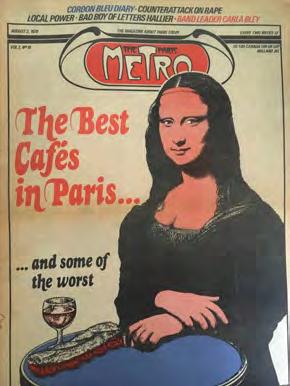
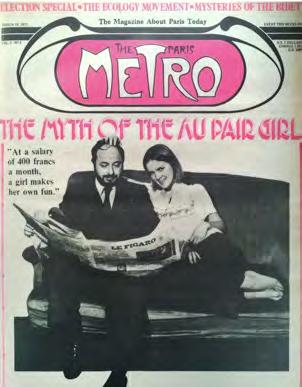
Though it would last for only two years, the Metro became a gravitational force field for American journalists in Paris. “Writers would appear off the street,” Stein told me. Young Metro contributors like Frank Rich, Roger Cohen and Joan Dupont would go on to have international careers. The Metro itself became a fashion accessory - people who didn’t even read English bought the magazine, to see and be seen with le magazine hot
Most importantly, the editors and writers - and, it seemed, readers - were having fun. “The more we criticised the French, the more they loved us,” said Stein. The journalist Dominique Torrès, laid up in her apartment with a broken leg, wrote a column on ‘What’s In and What’s Out in Paris’. The column was blatantly arbitrary, yet many readers took it seriously, writing into the Metro that they’d pinned it to their kitchen walls. Stein and Stratte-McClure claimed, when I spoke with them, that Torrès’ column was the first of its kind, a precursor to hot-or-not indices like New York Magazine’s Approval Matrix. An early cover story featured an in-depth ranking of the best ice-cream shops in Paris, with an illustration of a cartoon figure licking a giant cone in the shape of an upside-down Eiffel Tower that transforms, in the final panel, into a bottle of wine. The major scoop: Berthillon, long-acknowledged crème de la crème of Parisian glacé, was ranked only fourth, because the owners had been rude to the Metro’s reporter.
For ‘The Doorman Bigger Than the Ritz’, an exposé on behind-the-scenes hotel life, Stratte-McClure interviewed a disillusioned teenager working as a bellhop at the Ritz - identified in his photo caption as simply “Henri, 18, Communist” - who reported very frankly on his experiences. “The Ritz is not the same for its employees as it is for guests,” he said. Not only did employees earn less in a month than top clients spent in a single night, “the basement [had] the smell of dead rats and the breakfasts they feed us are terrible”. But Stratte-McClure didn’t think through the ramificationsthough the Ritz wasn’t an advertiser itself, others might not be so comfortable signing over their dollars to a newspaper liable to blast them in its pages.
All of this came at a price. After the publication of an article entitled ‘Sex in Paris’, Stratte-McClure told me that
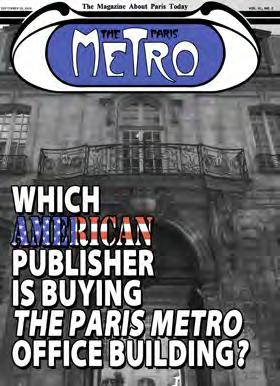
several potential advertisers simply stopped replying to calls. Despite the boon of some major companies such as Air France and Philip Morris advertising in its pages, the Metro was always bleeding money. Instead of retaining a strict low page count and therefore a limited printing budget, the magazine ballooned in size, sprawling to 50 colour pages. As Stein told me, “French media outfits, and banks started throwing money at us - alas, money that eventually had to be repaid. Had we retrenched, stayed at the initial 24 pages as circulation and advertising continued to build, we would have had a chance. But none of us understood that. Like most of us, I got my family to invest in the Metro, truly believing, idiot that I was, that it was destined to be a mammoth success.” Even in the magazine’s last weeks, the editors were searching for a larger office to accommodate future daycare for pregnant staff writers.
In 1978, Stratte-McClure told me, the Metro put together a handshake deal with the Herald Tribune to become that publication’s Sunday supplement section. At the last moment, however, the Tribune pulled out. In retrospect, “the reason it didn’t work was pretty obvious,” Stratte-McClure stated. “We were half a million dollars in debt. No-one in their right mind would incur [that amount] in debt.”
Once that deal fell apart, it was lights out for the Metro.
The Metro was short-lived, but its legend has a long afterlife. A 2016 40th anniversary edition collection about the magazine features a nostalgia-larded parade of essays dedicated to chronicling those brief yet momentous two years, and there’s a television show in development about the glory days. And yet, the magazine is not digitised - if you want to look at all the back issues, you still have to actually go to Paris to read them.
Even this fact captures an element of expatriate Parisian life to which many writers wish we could return. Back then, Stein recalled, “Paris truly was a world away. You were really gone. Cut off from the States, didn’t make phone calls to people, no internet. Turkish toilets in every café. Everyone smoked Gitanes or Gauloises. Our whole sense of life was inhaling that noxious smoke”. Of course, this too is myth. As a friend of the Metro put it: “It’s hard not to feel like the rest of life couldn’t have been as fun as that.” n
THE TALESE WAY
Internationally acclaimed author Gay Talese never lets technology get in the way of finding a great story.
By Rhonda Palmer
Gay Talese has written 15 books. He was a reporter for The New York Times from 1956 to 1965, and since then he has written for the The New Yorker, Esquire, and other American publications.
Talese was born in Ocean City, New Jersey, and currently lives in New York City. His groundbreaking article ‘Frank Sinatra Has a Cold’ was named the “best story Esquire ever published”, and he has been credited with the creation of an inventive form of non-fiction writing called the “New Journalism”.
“What impressed Talese’s first readers was his discursive storytelling and insider take. For this he was credited by Tom Wolfe with inventing the New Journalism, a firstperson narrative technique later adopted by Norman Mailer, Hunter S. Thompson, Joan Didion and Wolfe himself, among others,” wrote Stephen Smith in an article for The Guardian. “We have this self-referential formula to thank for the columns that fill the papers now, roaring confessionals about throuples and wild swimming. But today’s readers, and particularly other journalists, will be astonished by the access Talese had, not to mention freedom from nixing PRs.”
The curse of modern technology is that it connects us, and that it also isolates us. Nowhere is this more obvious than in journalism, where the writer-subject interaction is regularly reduced to 10-minute Zoom interviews, half a dozen email questions, or a 140-character X conversation that not only saves time, but also lets a writer get on with a story without the complication of getting socially involved with a stranger.
Well, Talese is having none of that.
Although he does have an email account and a website hosted by his publisher, he is a rare public figure, totally absent of his own accord from the instant worlds of Facebook, Instagram, X, Bluesky or any other social media platforms. Instead, the legendary 93-year-old writer and author has made his living, built his reputation and garnered the vital substance of all of his uniquely styled, impeccably researched stories through building and fostering old-fashioned face-to-face relationships. “You have to be there to get the story and you have to be stubborn,” he says, explaining his modus operandi. “You then have to empathise, gain people’s trust and get a foot in the door. You need to be able to see their face and how they are reacting.”
Over and over again, Talese has used the slow-build, personal approach to create a story narrative that most other people would not have either the patience or the skill to achieve. This is clearly evident in his most famous piece ‘Frank Sinatra Has a Cold’ published in Esquire in 1965 and
quoted to journalism students everywhere. It’s also there in his best-selling story of a Mafia family entitled ‘Honor Thy Father ’, and again, in perhaps his most spectacular getgiven that he arrived in a strange country and was working basically from scratch on his piece on Chinese female soccer player, Liu Ying, whose story he included in his 2006 book, ‘A Writer’s Life ’. “I just happened to have the TV on one day and saw her miss a penalty kick in the 1999 FIFA Women’s World Cup final, causing China to lose to the U.S., and I got to wondering about how she was treated by her teammates, and by her friends when she got back home, or if her parents would be ashamed of her,” Talese recalls. “When I saw this little Chinese girl living through a dark moment, I wanted to talk to her about how she felt because I thought it would make a good story.”
Talese was based in New York and Liu was somewhere in China. The author had never been there, but had a few friends in Hong Kong at TIME magazine, so he hopped on a plane and went after the story. He landed in Hong Kong, where despite warnings of an impossible language barrier and a general wariness of foreigners in the Mainland, he collected a two-week tourist visa for China and headed to Beijing.
After the first two weeks, Talese went back to Hong Kong to obtain another two-week permit. This became a routine and ultimately he spent a total of five months in China, commuting to Hong Kong for a visa run every couple of weeks.
On his first trip, a cold call to a sporting goods company had produced an English-speaking Chinese adviser and amateur translator to spend time with, who in the weeks that followed, enabled Talese to communicate with government departments, which then led to a familiarisation lunch with officials, and later presented the opportunity to convey an official request to the Sports Ministry, seeking access to Liu.
It’s a clear illustration of his gift for socialising that a Westerner was able to quickly increase his circle of Chinese “hanging out” partners to the point where his Beijing contacts ranged in status from salaried men to high-level government officials. As he nurtured their friendship and fostered their trust, they helped him move closer and closer to his interview target. At one lunch with key members of the Sports Ministry, Talese told them that he saw the soccer girl’s story as representative of China. “I said that the country had achieved many great things, and although occasionally there was a misstep, like her, they kept moving forward. The Ministry of Sport people liked my story so they said I should send them an official request and they would help arrange
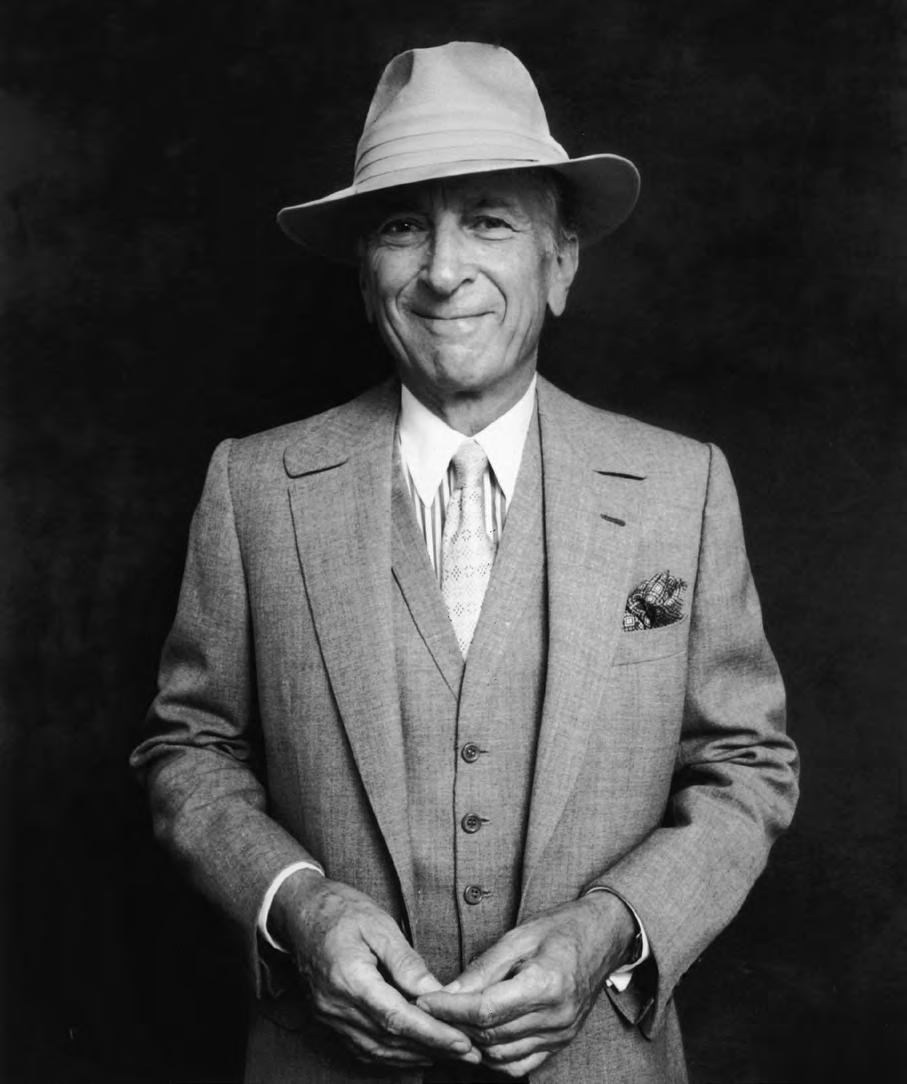
for me to meet her. And they did. However, when we met, she didn’t speak English and I spoke no Chinese, so they had a government official there to translate, but she was quiet, slightly nervous, and didn’t say much.”
At that point many journalists would have cut their losses, cobbled a story together from what they had and headed home. However Talese was not finished and over the coming weeks he looked at ways to build the story. “I cultivated the family to trust me,” he says, explaining that he made contact with Liu’s brother and mother and ultimately her whole family, including her grandparents who lived all together in a downtown Beijing hutong. He also started spending time with the Chinese soccer team and even went to Australia
with them to watch their matches at the Sydney Olympics.
Ultimately, with input from Liu’s family and a wider circle of friends and associates, Talese completed a multi-faceted tale of aspiration, triumph, loss, failure and redemption that no magazine wanted at the time and remained unpublished until it featured prominently in his 2006 memoir, ‘A Writer’s Tale’.
Talese followed Liu’s career for a while, however he and Liu last saw each other around 20 years ago, at which time she was still single and teaching soccer at a high school, which the author says makes him happy. After all his fears for her future when she slipped up at the World Cup, Liu had ended up with the opportunity to pass her knowledge to the next generation.
“That’s a worthy profession,” he says. n
STAFF SPOTLIGHT:
TONY YU / DEMI CHEF
Catering to a broad diversity of Members’ tastes across the culinary spectrum is a tall order, but for Demi Chef Tony Yu, it’s all in a day’s work. We continue our Staff Spotlight with observations from General Manager David Brightling about the special nature of Club employees and speak to Tony, who has been working in the FCC kitchen for just over three decades.
By Christina Pantin Portrait by Lakshmi Harilela/Love True Light
David Brightling, General Manager of the FCC, has run social, yachting and recreational clubs in Hong Kong, Singapore, Taiwan and Canada, and has insights into the unique alchemy between club employees and members.
Noting the recent celebration of long-serving FCC staff, David observed that this was a track record that few restaurants, hotels or resorts could match. “Such dedicated, long-term service has its foundation in the unique culture at clubs, where long-time – often multi-generational –members interact with long-time – and at some clubs multi-generational – staff! It’s a bit like the American sitcom Cheers where ‘everybody knows your name’ and staff can anticipate a member’s drink order before they even sit down.”
Asked why it was important to recognise less visible FCC employees, David notes that front-of-house employees tend to be first in line for appreciation from Members, whether shown through Lunar New Year ‘ lai see ’ or gifts at Christmas. “Meanwhile, there is a whole army of unsung and unseen heroes working quietly behind the scenes to help enhance the club experience. These range from cooks and dishwashers toiling in a hot kitchen to housekeepers, laundry room staff who handle linens and uniforms, maintenance staff who keep our ageing mechanical, electrical and plumbing systems working, as well as purchasers, accountants, clerks, marketing and social media staff and so on.”
Being featured in The Correspondent “is an important intangible reward for them, a way to ensure that they know their efforts are truly appreciated,” he adds.
Well said, David. Read on for a snapshot of one of the many “unsung heroes” and look out for other profiles in future editions.
Tony, what do you do as a Demi Chef?
I handle breakfast, and I also prepare sauces and ingredients. I do carving and the laksa station as well.
How did you join the FCC?
A friend recommended me to apply for a job. Previously I worked in sales and logistics at a wool company in Hong
Kong. They had a factory in China and a trading company here in Hong Kong.
Did you have a background in cooking?
I previously made wonton noodles and have always loved food. I’m a foodie!
What did you learn about Western cooking at the FCC?
I learned how to handle a knife and how to chop; I used to practise at home. Steak and lamb chops are my favourite things to cook now. I didn’t know how to make a salad before, but because of split shifts, I have learned by working on different stations.
What’s your favourite menu item at the FCC?
Shepherd’s pie. I love to make it, and I try to make sure it’s healthier by making it less oily. I also love seafood soup.
What does a typical work day entail for you?
I report in at 6:30 am as we open at 7:00 am for breakfast. I bake the bread and prepare ingredients as I handle all of the breakfast cooking. I then prepare the filling for the shepherd’s pie and the spaghetti sauce. At lunchtime, I handle the carving station and help with the overall lunch operations. I finish work at 4:00 pm.
Do you receive compliments from members on the food? (Laughs) No, I don’t because I’m usually in the kitchen. But if we have no complaints, it’s a good day!
What are your favourite holiday menus?
Christmas because it’s very busy and they’re long days; roasting the turkeys and preparing for the lunch and dinner buffets.
You’ve spent 31 years working at the FCC. What’s your advice for a long career?
Stay positive and don’t give up early. Don’t say negative words. I just try my best and want to make sure our guests are satisfied with the food. I focus on my area, for example when making the shepherd’s pie, I make sure I handle the whole process instead of delegating it to someone else. n

FOOD FOR THOUGHT
AN HOMAGE TO SPANISH CUISINE
This August, the FCC pays homage to the culinary spectrum of Spain under the expert guidance of guest chef Edgard Sanuy Barahona, Head of the Spanish Division at the Epicurean Group. Having worked in Hong Kong for more than a decade, Edgard fully believes in the power of Spanish cuisine in bringing people together to fully enjoy a meal around the table.
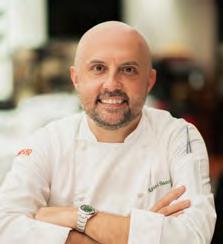
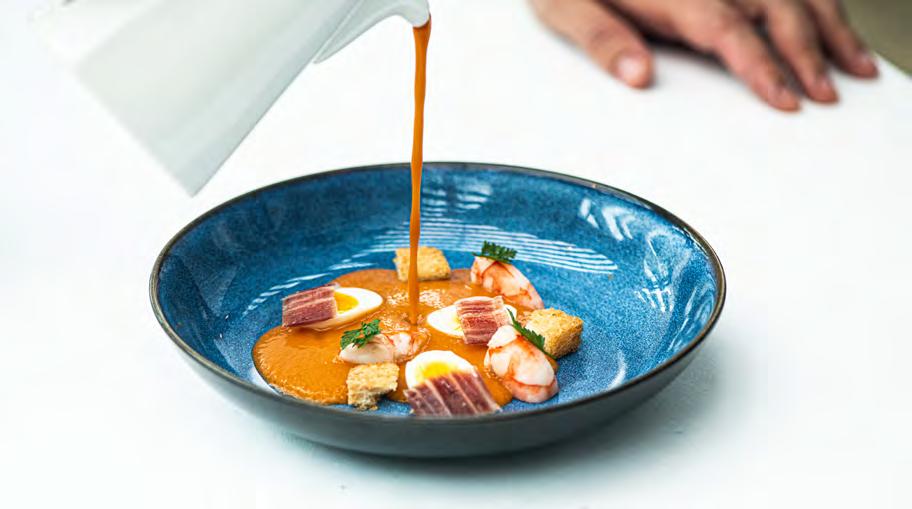
Chef Edgard Sanuy Barahona originates from Lleida near Barcelona and his passion for the culinary arts was ignited when working in his uncle’s Spanish restaurant in Tokyo, which led to his enrolment in the prestigious culinary school Escuela de Hostelería Hofmann in Barcelona for professional culinary training.
Edgard joined the Epicurean Group’s leading collection of restaurants and bars in 2017 and he curates the menu and oversees the guest experience at Hong Kong tapas restaurants Pica Pica and Bàrbar, as well as at newcomers Aire and Pintxos.
“My style is about capturing the soul of Spanish cooking –its emphasis on pristine ingredients, vibrant simplicity, and conviviality – and allowing that to converse with the energy and exceptional produce I find here in Hong Kong and Asia,” he says during a photo shoot of a selection of the dishes he will be presenting at the FCC.
Imagine the pure intensity of a trio of layers – marinated lamb, slow-roasted, sun-drenched Catalan tomato and lightly pan-fried spring onion elevated by a drizzle of premium olive oil, or the simplicity of the finest anchovies on a bed of fresh tomatoes with just the right amount of garnish. Chef Edgard’s dishes are characterised by their clarity,
balance, and respect for ingredients. He champions seasonal sourcing, building relationships with purveyors to secure the finest seafood, premium meats, and exceptional local and imported vegetables. He avoids overwhelming complexity, believing that three or four extraordinary elements, treated with precision and care, create a more impactful and honest dish than multiple flavours fighting for attention. His Gazpacho, for example, features just a few perfectly cooked treasures from the sea, allowing their natural sweetness to shine through the flavourful tomato base.
Beyond the plate, Chef Edgard embodies a philosophy of “emotional connection”, understanding that dining in Hong Kong is about much more than sustenance; it’s about creating memorable journeys. His food is designed to evoke warmth, spark conversation, and transport guests – whether to the Catalan seaside or simply to a moment of pure, unadulterated pleasure.
4 – 30 August: Spanish dinner promotion by Edgard Sanuy Barahona /Spanish wine promotion
15 August: Spanish Set Menu Dinner by Edgard Sanuy Barahona


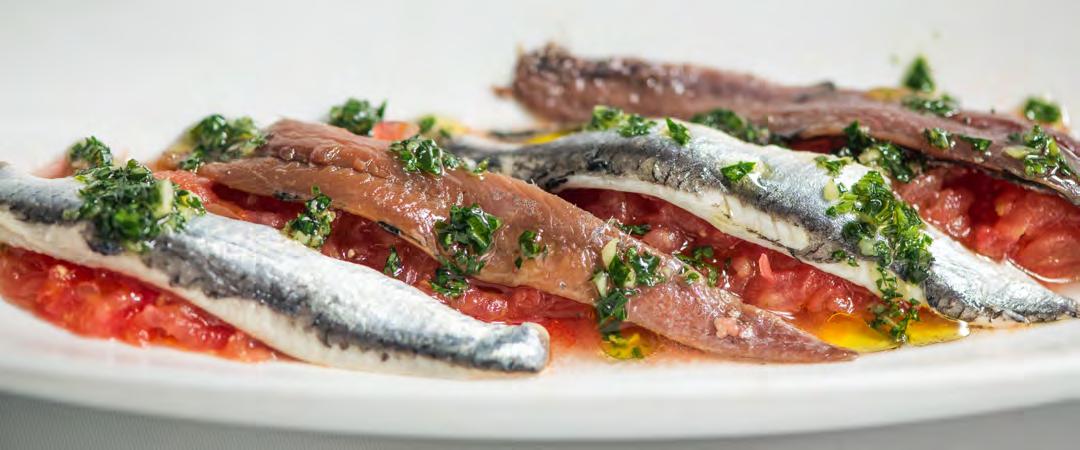
THE SPIRITED JOURNEY OF TEQUILA

Tequila’s story begins not in a sleek cocktail bar, but in the volcanic soils of Jalisco, Mexico, where the majestic blue agave plant has thrived for thousands of years. Long before distillation arrived with Spanish conquistadors in the 16th century, the indigenous peoples revered the agave. They fermented its sap into pulque , a milky, mildly alcoholic ritual drink consumed during sacred ceremonies. When the Spanish ran low on imported brandy, they applied their distillation techniques to the abundant agave, creating a rough, potent spirit known as vino de mezcal.
By the 18th century, production began in earnest near the town of Tequila in the Mexican state of Jalisco, about 60 kilometres northwest of Guadalajara, giving the spirit its name. Pioneering families such as José Cuervo (founded in 1758) and Sauza (founded in 1873) established the country’s first commercial distilleries. Early tequila was a little rough around the edges – often sipped neat by labourers or used as medicine. Its distinctive character came from roasting the agave hearts - piñas - in earthen ovens, crushing them with a stone wheel, and fermenting the extracted juice.
For much of its history, tequila remained largely confined to Mexico. Its global ascent began in the mid-20th century, fuelled by two key factors.
While its exact origin is debated – some attribute it to Texan socialites, others to Mexican bartenders - the ‘Margarita’ exploded in popularity post-World War II. This simple, refreshing combination of tequila, lime juice, and orange liqueur (usually Cointreau or Triple Sec), often served salt-rimmed, became one of America’s favourite cocktails. It transformed tequila from a novelty shooter
into a versatile mixing spirit, showcasing its bright, citrusfriendly profile.
For decades, much exported tequila was low-quality mixto (only 51% agave), but the debut of the Patrón brand in 1989 was a game-changer. Marketed as a ultra-premium 100% blue agave spirit, attractively packaged and designed for sipping, Patrón proved tequila could possess complexity, elegance, and terroir. This led to a plethora of artisanal and boutique tequilas flooding the market and being categorised by age – defined by terms including Blanco, Reposado and Añejo
The premium boom coincided with the global craft cocktail trend, and bartenders, no longer satisfied with the simple Margarita, began exploring tequila’s versatility.
Classics such as the Paloma (tequila and grapefruit soda) flourished, while tequila’s herbal notes began to shine in twists on the Old Fashioned. Its crispness also elevates ‘sours’ and ‘highballs’, while its earthy depth adds complexity to Negroni variations and spirit-forward stirred drinks.
Mixologists now treat high-quality tequila with the same respect as single malt Scotch or small-batch bourbon. They highlight its unique characteristics – the peppery bite of a young Blanco or the vanilla-oak notes of an Añejo –often using minimal ingredients to let the spirit itself sing.
From 1 – 27 September, Bert’s will be offering a Mexican snack and cocktail promotion with Bar Supervisor Diwash Gurung presenting his versions of the Paloma (tequila, fresh lime juice and pink grapefruit soda garnished with a grapefruit slice) and a Sangrita (tequila, fresh orange juice, tomato juice, lime juice and hot sauce, garnished with lime leaves). Mocktail versions of both are also available. n
A SPLASH OF ROSÉ
On 13 May, Members gathered for a convivial Rosé Wine Social, enjoying the products of more than 20 wineries and a buffet dinner. Special thanks go to Elaine Pickering and Houghton Lee from the Wine Committee for their pre-tasting speeches. The top-rated wines are featured below as the Wines of the Month in July and are the perfect tipple for the heat of the summer.
Ken Forrester Vineyards Petit Rosé 2024
Stellenbosch, South Africa
Grenache, Viognier
Aromas of freshly picked strawberries, rose petal and cherry flavours. It follows through on the palate with delicious ripe raspberries and a delicate finish.
Glass $48 / Bottle $240
AIX Coteaux d’Aix-en-Provence Rosé 2023
Provence, France
Grenache, Syrah, Cinsault
A fresh pale pink in colour. Floral nose with violet notes, red berries and ripe citrus. Fresh and structured with a crisp acidity, juicy red fruit, citrus notes and good length.
Glass $62 / Bottle $310
Tenuta Corte Giacobbe Pinot Grigio Ramato Rosé 2023
Veneto, Italy
Pinot Grigio
The bouquet opens with dominant notes of ripe peach, gracefully interwoven with hints of tropical pineapple and delicate floral whispers reminiscent of spring wildflowers. On the palate, it is silky and refined, yet confidently structured and full-bodied. A vibrant crispness carries through to a lingering, majestic finish.
Glass $52 / Bottle $260
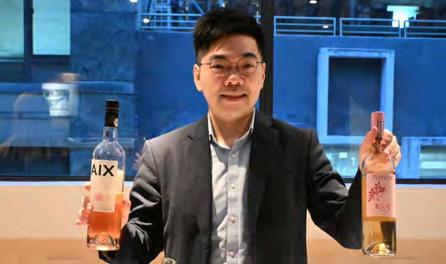
Planeta Rosé DOC 2023
Sicily, Italy
Nero d’Avola, Syrah
Pearl pink in colour with aromas of small pastries, currants, Sicilian wild strawberries and hints of plum and pineapple. Very supple, with just a hint of acidity. An extremely pleasant wine.
Glass $56 / Bottle $280
Rumours Pink Moscato 2023
South Eastern Australia
Pink Moscato
Vivid rose pink. A lifted nose of fresh strawberries and cream. The palate displays cherry and strawberries, finishing with a light spritz.
Glass $44 / Bottle $220
Unico Zelo Origami Rosé 2023
Riverland, Australia
Grenache, Sangiovese, Dolcetto
Notes of fresh cranberries, pink lady apple, guava and salted lemon. Texturally delightful, great acidity and an excellent dry finish with a nice phenolic grip. Fresh, vibrant and bone dry.
Glass $62 / Bottle $310
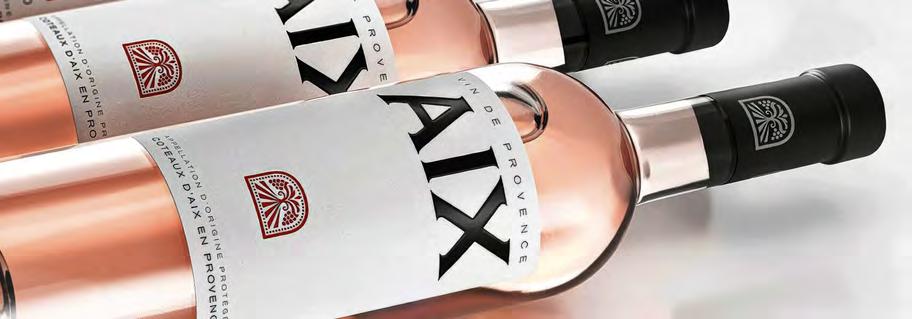
ALL THINGS BRITISH IN THE HEART OF BANGKOK
By Mark Kuuse Images: Courtesy of The British Club Bangkok

As a reciprocal member visiting from Hong Kong, I recently had the pleasure of experiencing The British Club Bangkok for the first time. Accompanied by a few friends, also first-time visitors, we were warmly welcomed into what can only be described as a distinguished oasis of British tradition and hospitality in the heart of Bangkok.
Our visit began with lunch at the Churchill Bar, where we enjoyed a classic British pub experience - hearty pies and perfectly poured pints of Guinness. Of course, when in Rome, the Thai food that a friend had was first class.
Following lunch, we made our way to the Club’s magnificent outdoor pool. Surrounded by lush greenery and bathed in sunshine, it provided a refreshing escape from the city’s heat. Reclining on loungers with a bottle of rosé, we found ourselves fully immersed in the Club’s tranquil charm.
So impressed were we that we returned the following day. This time, we began with a game of snooker in the Games
Room, accompanied by gin and tonics, before enjoying dinner at the Veranda. Everyone chose to have steak and we were not disappointed.
As with any visit to a reciprocal club, I always enjoy a deep dive into the Club’s website ahead of the visit. Beyond its excellent facilities and dining, it enjoys a rich heritage. Established in 1903 you can feel the history throughout the establishment.
Whether you have a few hours or an entire afternoon to spare, I wholeheartedly recommend a visit. The British Club Bangkok offers a taste of all things British, tucked away up a side street in the heart of Bangkok. n
The British Club Bangkok
189 Silom 18, Suriya Wong, Bang Rak, Bangkok 10500, Thailand
Tel: +66 2 234 0247 britishclubbangkok.org
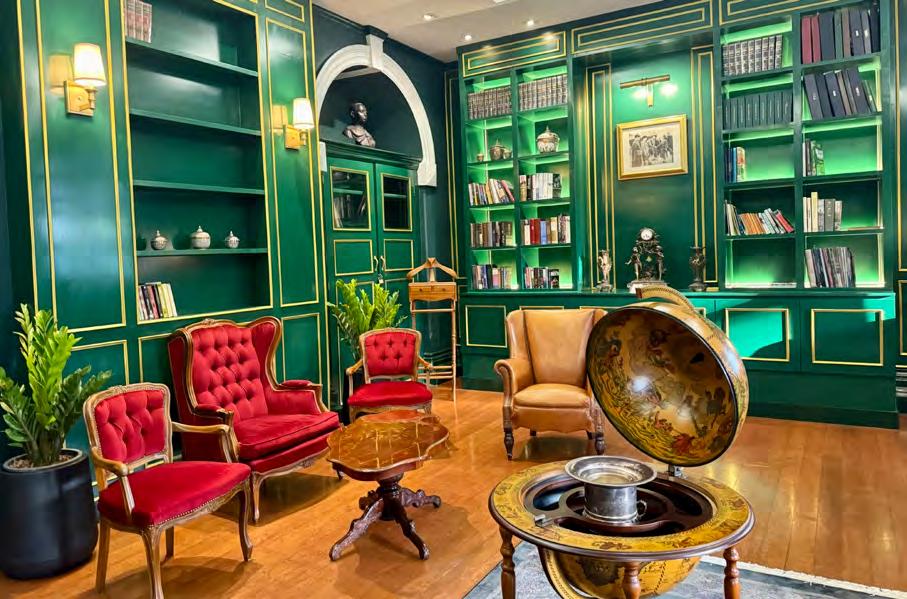
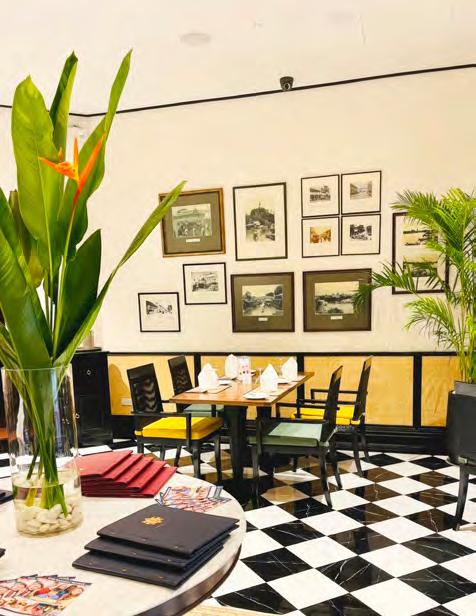
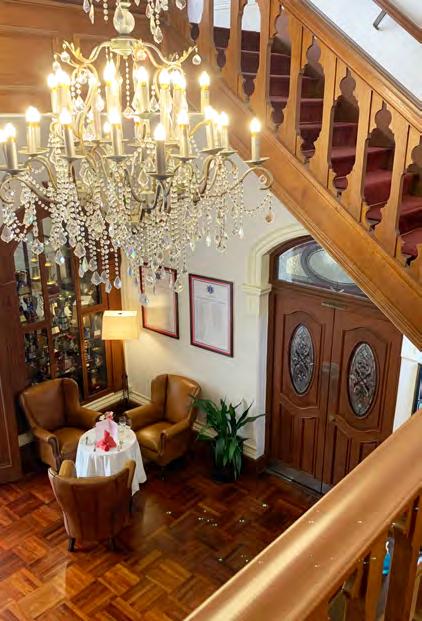
The Wordsworth Lounge
The Verandah restaurant Main staircase
NEW ON THE BLOCK
The FCC extends a warm welcome its new Members who come from a wide range of sectors, further adding to the diversity of the Club. Here’s a summary of who they are and what they do.




CORRESPONDENT
KATELL ABIVEN
Asia-Pacific Editor-in-Chief
Agence France-Presse
Hi everyone! I moved to Hong Kong in January to become Editor-in-Chief for Asia-Pacific at Agence France-Presse (AFP). I am French, but have been living overseas for 15 years now, first in Spain, then in Latin America (Uruguay and Cuba), and in Beijing for the past three years as China and Mongolia Bureau Chief. I have been lucky enough to have my family following me around for all these years - I have a husband and two kids. As you may have guessed, I enjoy travelling and also learning languages; I even studied Esperanto at some point! I am fluent in English and Spanish, and I have some basic knowledge of Chinese, Japanese and Korean.
www.linkedin.com/in/katell-abiven
CORRESPONDENT
KE HANYAN
Freelancer
A curious observer and storyteller, I have called both Beijing and Hong Kong home - first as a student, now as a wanderer between cultures. I love travelling, discovering stories in cities, and connecting with people. Let’s share ideas and experiences.
www.instagram.com/sylviakeke__1 linkedin.com/in/hanyan-ke-126517305
CORRESPONDENT
LU JIAXIN
Freelance Multimedia Journalist
Agence France-Presse
I left my full-time job and I am now a video stringer at Agence France-Presse (AFP), a part-time teaching assistant in the journalism department at The University of Hong Kong, and an occasional content strategist and producer. I have filmed and written stories for AFP and helped produce feature shows for CNN. Before moving to Hong Kong to attend university, I was born in Xiamen and spent some time in Shanghai for high school. I also spent a year in Sweden for my exchange study. I love music, taking pictures, and have recently taken up running. I’m aiming to complete a marathon this year and am just keeping a record here to motivate myself!
www.linkedin.com/in/jiaxin-lu-45ab2612a www.instagram.com/awfulusphoto/
JOURNALIST
NEIL DOLBY
Magazine Features Editor
Total Media Ltd.
During my time in Hong Kong, I have been involved in a wide variety of journalistic and editorial assignments. This includes stints with publications concerned with international trade, shipping, and aviation. I also worked for an insurance-related business involved in loss adjusting. For the past two years I have specialised in the luxury lifestyle sector, with a focus on travel, wellness, auctions, watches, and wine. I obtained a Distinction for my Master’s degree in the economics of natural resource and environmental management at Cranfield University. I enjoy hiking and stream trekking, and have travelled extensively. I have visited many countries in Europe, India, China, Southeast Asia, Australia, New Zealand, the Pacific, and the U.S.

ASSOCIATE
CHEUNG YAT SUM, MARIA
Chief Executive
Fair Trade Hong Kong Foundation
I am the Chief Executive of the Fair Trade Hong Kong Foundation (FTHK), a fair trade marketing organisation of Fairtrade International. Aspiring to create a fairer and better future, I promote ESG (Environmental, Social and Governance) and SDG (Sustainable Development Goals), and appeal to the business sector, schools and universities to support the fair trade movement in Hong Kong. Before joining FTHK, I engaged in image building and employer branding, advertising and promotions, mega-event management, stakeholder engagement, media and investor relations, issue and crisis management, sustainability, and the operations of several charity foundations and corporate volunteer teams. I am an Executive Committee member of the Hong Kong Public Relations Professionals’ Association and a member of the Fundraising and Promotion Committee of the Agency for Volunteer Service. I love travelling, enjoying good food, practising yoga, and hiking.
www.linkedin.com/in/maria-cheung-7b6177200/

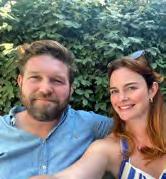
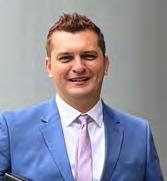
ASSOCIATE
ANDREW FUNG
Wai Kwong Consulting Co. Ltd
I previously served as the Information Coordinator for CY Leung’s administration and was also elected as a District Councillor for the Southern District. Since my university days, I have travelled frequently to Xizang and Xinjiang in China. In addition to writing current affairs commentaries, my favourite activities include cycling more than 20 kilometres daily and capturing aerial photography. My photography collection, titled ‘Journey of the Dragon’, features stunning landscapes from China’s border regions and is available for purchase at the FCC. The globally renowned drone manufacturer, DJI, has also used my aerial photographs in its latest photography collection.
ASSOCIATE
ALASDAIR HENDERSON
Director
BlackRock
I moved to Hong Kong in 2024 because my wife had been offered a role with her firm in the region, but it wasn’t my first time, because my father was born here and three generations of my family have lived and worked here. In that respect it’s great to continue the family tradition as the city has much to offer and I’m looking forward to exploring more of Hong Kong and the region. I currently work for BlackRock looking after some of our technology clients in the SAR. Alongside a passion for history (particularly military history), I’m a keen follower and occasional player of rugby and cricket, and am always keen to discuss these over a glass of wine.
ASSOCIATE
CHRIS-ANGELO HERSELMAN
Global Co-Chief Operating Officer
Trust & Fiduciary Service, HSBC Private Banking
With South African roots, I have cultivated a dynamic global career, spending more than a decade in East and Southeast Asia. As a Chartered Accountant with 25 years of experience, my professional journey includes navigating international trust management, public accounting, and holding key leadership roles at HSBC. My entrepreneurial spirit has driven me to launch successful ventures across diverse fields, including cryptocurrency, online education, and nutrition, reflecting my passion for innovation. A curious traveller, I thrive on cultural exploration, whether on land or beneath the ocean’s surface, always eager to learn from new experiences. My competitive nature shines through my love for ball sports, particularly rugby, cricket, and tennis. I look forward to connecting with like-minded professionals at the FCC and sharing valuable insights in our fields.
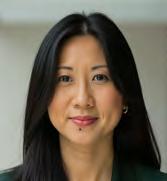
ASSOCIATE IN JU-HIE
Founder and Director
JIN Consulting
Hi, I’m Julia, founder of JIN Consulting, a communications coaching company empowering professionals to master media interviews. I’m passionate about transforming people into confident, dynamic speakers who excel under pressure. Words matter - one perfect word builds connection; a wrong one risks a reputation crisis in today’s media landscape. As a former journalist with 16 years of experience securing top media headlines for global senior executives, I have crafted and polished their speeches, set the tone and helped them to nail high-profile interviews.
A long-time Hong Konger, hockey wife, and mum, I embrace a sporty lifestyle. My multicultural upbringing in Hong Kong, enriched by French and Korean influences, shapes my authentic approach to communication and forging connections with our vibrant community.
https://www.jinconsultinghk.com/ www.linkedin.com/company/jinconsultinghk/ bio: www.linkedin.com/in/juliainhk/
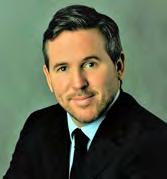

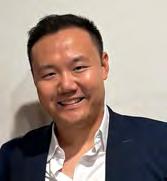
ASSOCIATE
MARK DEAN JONES
CEO
Kingswood Capital Solutions
This is my second stint in Hong Kong, having lived here between 2010-2018 before leaving for New York and then retuning at the end of 2023. I founded my advisory business while living overseas and have worked on projects as diverse as sports technology utilising AI to afforestation in India. I am due to climb Mount Kilimanjaro in October for Parkinson’s (U.K.), from which my father suffers. I was born in the U.K. and attended the University of Warwick. I am married with a three-year-old son and I am a keen tennis player, avid reader and traveller.
ASSOCIATE
DOUGLAS LAM
Associate Director
PwC Hong Kong
Born and raised in Hong Kong, I have been a valuation specialist covering private equity and private credit with a global audit firm for more than 17 years. By the grace of God, I regularly attend services at St. John’s Cathedral. Apart from being a server, I am a regular lay reader and intercessor. Not only am I part of the English Bible Reading Fellowship, I also participate in various ecumenical activities, such as Anglican-Catholic joint retreats and events. What’s more, I am active in the corporate responsibility programmes of my firm, the volunteer work of the Rotary, and the outreach work of the church.
ASSOCIATE
JUSTIN LAZAR
Project Associate
The Amber Foundation
I’m a project associate at The Amber Foundation, working on the Toiletries Project, where I manage logistics and communications for donations across Hong Kong. We actually have a collection point at the FCC, just around the corner from the concierge desk. I was born and raised in Hong Kong but studied abroad at Oxford Brookes University in the U.K. The COVID-19 pandemic was a watershed moment - it shifted my values and led me to the non-profit sector, where I felt I could contribute to something more meaningful. Outside work, I enjoy playing squash and golf, usually fitting in a session or two each week. I love travelling, exploring local histories, and trying new foods. I’m also a voracious reader, especially of historical writing and geopolitical analysis - it’s how I stay connected to the wider world.
www.theamberfoundation.org/the-toiletries-project justin@theamberfoundation.org.hk
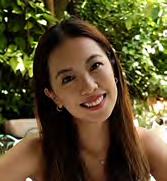
ASSOCIATE
CATHERINE LEUNG KA YAN
Partner, Head of Employment
Lewis Silkin
While technology is an inescapable part of modern life, my all-time favourite pastime is picking up a good paperback and curling up in a comfortable chair for hours. I have a particular interest in the topics of human behaviour and psychology, and I enjoy meeting new people from all walks of life. One day, I hope to train as a counsellor so that I can support others in a more direct and meaningful way.
As for now, I am an employment partner and co-head of the Lewis Silkin Hong Kong office, a leading employment law firm conveniently located just down the road on Duddell Street. I find joy in working with clients and colleagues alike, and I am grateful for the travel opportunities my work has afforded me. Outside of work, I share my life with an adorable pup named Buddy, my husband and two wonderful bonus kids aged 23 and 27. I look forward to becoming part of the FCC community and getting to know fellow Members - whether through a shared love of books, lively conversation, or simply enjoying the unique atmosphere of the Club.

ASSOCIATE
ANDREW NOAKES
Head of School
Stamford American School Hong Kong
I am pleased to have become a new Member, having recently moved to Hong Kong with my wife Sally, to become Head of School at Stamford American School.
Originally from the U.K., I have lived and worked in France, the U.S., Abu Dhabi and Singapore. We have four grown-up ‘children’ between us, three girls and a boy; most of whom are West Ham United and Bedford Blues Rugby fans, having been season ticket holders of both over the years. Having read European Studies and French at university, I went on to obtain my MA in Education. I have taught primary and secondary-aged children in single-gender, co-ed and diamond-structure schools. The chance to broaden the minds, views, understanding, and abilities of tomorrow’s adults on an international stage is a welcome and rewarding opportunity. We are enjoying being Members of the FCC, and hope to make more acquaintances. Thank you for accepting and welcoming us!
ASSOCIATE

DAVID TSE
Managing Director
Hop Yuen (Holdings) Ltd.
Born and raised in Hong Kong, I am the Managing Director of Hop Yuen Construction, a family-owned company founded by my grandfather which has a 111-year history of specialising in construction and repair works, as well as serving as a specialist contractor in railway repair, trackbed maintenance and infrastructure support. Besides the construction business, I set up the Hop Yuen Charitable Foundation more than 10 years ago, as I believe that giving is important, especially to the less fortunate in the community. We have collaborated with various NGOs in Hong Kong on their meaningful initiatives. When I’m not working, I like to spend time with my family, including my grandsons. I also enjoy reading, hiking, and collecting pens.

ASSOCIATE RINGO TSE
Associate Principal
KPF Architects and Planning Consultants
Hi, I’m Ringo! You’ll often find me at an architectural design studio in Jardine House or on construction sites across Asia. When I’m not immersed in design, I love attending concerts at City Hall, especially when Rachmaninoff is on the programme, or training for dragon boat racing amid scenic islands. I enjoy soaking up art and geography while playfully comparing engineering and city planning across cultures. I’m an executive board member of Penn Club Hong Kong and several school clubs - Leges Sine Moribus Vanae, 厚德载物 and Best of the Best. I truly appreciate the FCC’s stunning architecture and its commitment to our shared values. See you all at Bert’s! www.linkedin.com/in/ringotse/
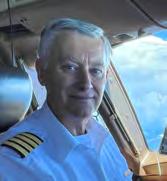
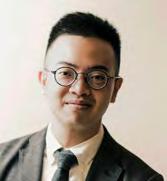

ASSOCIATE
GREGORY WHEELE
Airline Pilot - Senior Training Captain
Cathay Pacific Airways
I have worked in Hong Kong for 29 years and I am currently a senior training captain with Cathay Pacific Airways. I am fortunate to have a very satisfying role in training and assessing pilots of all experience levels. Music takes up a sizeable portion of my spare time and I am assistant organist at St. John’s Cathedral and Chairperson of the Cathedral Choir. My younger years were spent as a fighter pilot in the Royal Air Force flying many types of fast jet aircraft. I enjoy spending time with my family, running, hiking and travelling.
ASSOCIATE
YEUNG YAN LOK, FELIX
Conductor and Organist
Hong Kong Sheng Kung Hui & St. John’s Cathedral
As a musician born and raised in Hong Kong, I have been making music from a very young age. After graduating from the Chinese University of Hong Kong as an organist, I went to London to study Choral Conducting at the Royal Academy of Music, which was followed by two more fruitful years as organ scholar at the famous London Oratory. I am currently the Provincial Music Director of the Hong Kong Sheng Kung Hui (Anglican Church), as well as the Director of Music of St. John’s Cathedral. Outside church, I am also Music Director of the outstanding chamber choir Die Konzertisten and the male-voice ensemble Moderati. Hitting the gym, learning languages, reading Haruki Murakami, and brewing my own coffee combine to make my perfect day.
ASSOCIATE
BENJAMIN YIP
Co-Founder
Valerie Constance
Hello FCC! I’m Ben. I was raised in Hong Kong but left when I was a teenager. My journey took me to the U.S. for university, followed by law school in Australia. Whilst practising law in Sydney, I met my wife Valerie, who was also a lawyer, and she ignited our entrepreneurial spirit. Shortly after getting married in 2019, we left Sydney and took a leap of faith by moving to Hong Kong to start our business, Valerie Constance, a personalised tech accessories brand. I look forward to making friends at the FCC by volunteering for charity, playing pool, bridge and having a drink together at the Main Bar. Finally, thank you to my friend Chris Barber for the introduction.
www.valerieconstance.com/ www.instagram.com/the.valerie.constance/
OTHER NEW MEMBERS
Duncan Gareth Moug
Lai Ching Tenmy Kong
CBRE Hong Kong Engineer Associate
DBS (Hong Kong) Ltd.
Wai Hon Lam Colliers
Bjoern Vogt HSBC
Artem Rodionov
MultiBank Group
Private Banker Associate
Excutive Director Associate
Senior Programme Manager Associate
International Business Dev. Manager Associate
Ching Yan Shanice Ng Student Associate
Hirday Uttamchandani Freelancer Associate
Wing Tsang Eugene Yim
Arun Bhavnanie
Wing Ping Ng
Benjamin McCluskey
Bernacchi Chambers Barrister Associate
PSO Wines Ltd.
Cathay Pacific Airways
Owner Associate
Retired Associate
Captain Associate
Jonathan Tai Hin Kwan Investment Management Associate
Mei Yee Wilda Au
Century 21 West Island Realty Agency Account Manager Associate
Benjamin Bede Quinlan Quinlan & Associates CEO Associate
Minoru Motooka
MY.Alpha Mgmt. HK Advisors Ltd.
Yunhua Shang Yide (Hong Kong) Arts Dev. Ltd.
Anthony Vasey
Herbert Smith Freehills
Anna Cheeran Verghese CNN
SVP Research / Hedge Funds Associate
Founder Associate
Sen. Registered Foreign Lawyer Associate
Sen. Producer, Digital Prog. Correspondent
Victoria Nassberg Actor / Singer / Voice-Over Associate
MEMBER MOVEMENTS
FULL NAME COMPANY
POSITION
CATEGORY ABSENT
David Matthew Fox AFP
Christopher D. Appleton Faye Holdings Ltd
Correspondent
Correspondent
Managing Director Associate
Neil Gardner Generali Chief Customer Officer Associate
Jeremy Alexander Lightfoot Carey Olsen (Hong Kong) LLP Partner Associate
Sytske Helena Maria
Kimman-Tepema Asia Yacht Services Ltd Director Associate
Kate Whitehead Freelance Correspondent
Alan Armitage The Magic Rat Company Managing Director Associate
Vivien Pong Drs. Nicolson & Associates Office Manager Associate
Ching Ching Mary Ho HKUST
Atsuko Ikematsu Farington Ltd.
Roine Leiringer University of Hong Kong
Adjunct Assistant Professor Associate
Managing Director Associate
Associate Professor Associate
Marie Claire Smyth Claire Smyth Counselling Counsellor Associate
Joseph Yao Curatio Medcon Ltd. Director Associate
Mamta Malhotra Max Trade Ltd. Director Associate
Connie Charlotte Berry Nan Fung Development Ltd. Treasury Director Associate
Peter Koveos South China Morning Post
Production Editor Asia Correspondent
Pekka Elias Antero Heikari Eurasia Supply Chain Mgmt. Ltd CEO Associate
Ming Sang Li Colliers
Brendan Richard Leitch Juniper Networks Hong Kong
REACTIVATED
Lister Chang
Valuer (Valuation & Advisory Serv.) Associate
Marketing Director Associate
Great Sun Estates Limited Director Associate
John Christopher Siddell Hong Kong Government Air Traffic Control Officer Associate
Johan Nylander Asia correspondent Correspondent
CHANGE OF CATEGORY - ACTIVE MEMBER
Kou Yu Eddy Li ABC News
PROFESSIONAL CONTACTS
PHOTOGRAPHERS
CARSTENSCHAEL.COM – Award-winning
Photographer. People - Corporate - Stills - FoodArchitecture - Transport. Tel: (852) 9468 1404
Email: info@carstenschael.com
CHRISTIAAN HART PHOTOGRAPHY, providing professional sports, commercial, corporate and aerial photography in Hong Kong and throughout Asia. Studio portrait sessions available, for more information visit www.christiaanhart.com or call +852 96878282
Video Editor, Asia Change to Silver

SOOTHE YOUR SOUL, LIGHTEN YOUR SPIRIT, GLADDEN YOUR HEART

HOUR OF LOVE - AM 1044 METRO PLUS Prison Visitation on the Air Every Sunday 7:30 - 10:00pm l Live on Facebook
A NIGHT AT THE OPERA
In April, the FCC was thrilled to host the Hong Kong Grand Opera (HKGO) for a wonderful Opera Soirée, blending an elegant dinner with captivating performances.
The evening began with welcoming speeches from FCC Associate Board Governor Barbara Yu Larsson and HKGO Project Manager Joyce Chan, who set a warm and inviting tone for the night.
The programme featured three distinct musical segments, starting with German music performed by soprano Joyce Wah-Sheung Wong 黃華裳 and baritone Jeremy Leung, whose vibrant energy engaged the audience. Following this, Joyce delivered a breathtaking rendition of excerpts from Donizetti’s Lucia di Lammermoor,
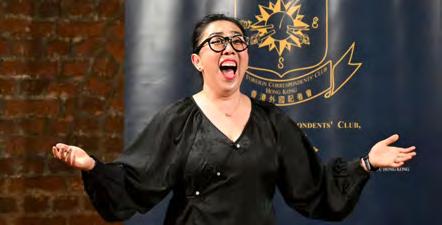

A SWEET EASTER
20 April brought a fun Easter celebration to the Club with a buffet featuring a chocolate fountain, chocolate cupcakes, assorted sushi and roasted U.S. beef striploin, among other temptations. Our younger guests were entertained with a cupcake workshop and a great day was had by all.

showcasing her powerful vocal range and the dramatic intensity of the piece.
Leung then took the spotlight for a musical theatre segment, charming the audience with his storytelling. Pianist Ingrid Chan accompanied all the performances, adding depth and richness to the evening.
The addition of an engaging Q&A session, which incorporated insights from HKGO Chairman KL Wong, gave attendees additional insight into the artists and the works performed.
The Opera Soirée left an appreciative audience eagerly anticipating future cultural events in this realm.

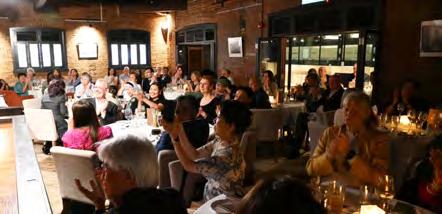

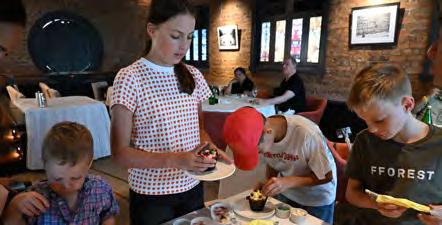
DISCO INFERNO
On 26 April, Bert’s was the place to be for revellers keen to indulge in a night of 70s - 90s music nostalgia at the FCC’s Disco Night. Members made an impressive effort to dress in theme and prizes were awarded to the Best Dressed and Best Dancer. DJ Eugene, who has been playing at clubs in both Hong Kong and Manila since 1990, was on the decks and kept everyone dancing under the all-important disco ball!

FOR THE LOVE OF MOTHERS

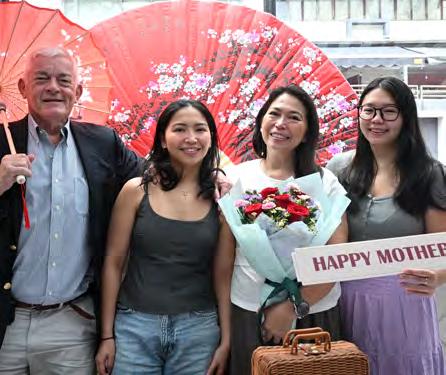

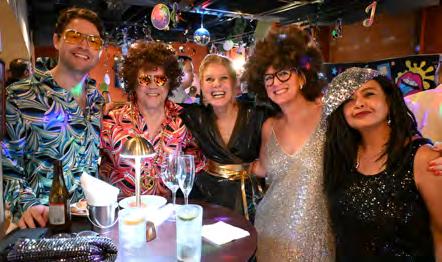
11 May marked the annual celebration of Mother’s Day and the Club celebrated with families and their beloved mums under the theme of ‘Hong Kong Nostalgia’. In addition to feasting on our Mother’s Day offerings throughout the Club, lovingly prepared by our culinary team, there was a prize for the best-dressed guest and all Mums in attendance were gifted with a chocolate rose. Photo ops were also aplenty.
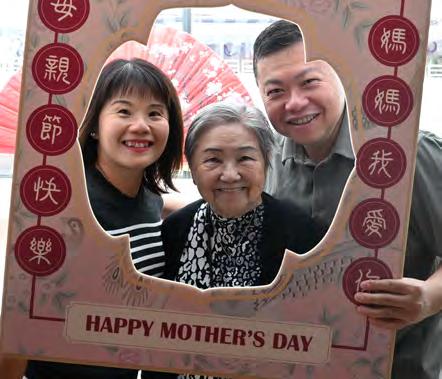
THE LABUBU EFFECT

Hong Kongers are renowned worldwide for a number of things. Firstly, for being incredibly irritable. As a recent viral Instagram reel succinctly put it, Hong Kongers aren’t racist; they hate everyone equally. Sure, not the greatest thing to be renowned for, but the locals own it, and that has to be respected.
Another key trait of being a Hong Konger is the sheer delight gained from standing in a queue. Everyone here is an expert queuer. One hour lunch break? No problem; will queue for 40 minutes in the baking summer sun just to eat at one’s favourite restaurant for 15 minutes. And lord save us if a new shop/restaurant/bar/coffee stand should open in Hong Kong – the queues are miles long.
Which gets us to the topic of this edition’s grumpy old man rant. To be honest, this could have been a five-word column, all in capitals, slapped on this big white page with “WHAT THE HELL IS LABUBU?” printed on it.
Because I’m so dedicated, I have been given orders by my FCC Correspondent Editor-in-Chief/Master-of-WeirdColumn-Ideas, Ann Tsang, to explore the phenom that is Labubu. Which is tough because none of it makes any sense to me.
Of course, I read the news back in April of the Labubu v3 launch (I assume that stands for “version”, though I had no idea there were others), eliciting Hong Kong’s famous queues for the little monster plushies.
Ok, first let’s look at the positives. The toy was created by a Hong Konger, Kasing Lung (who may or may not love to queue, I haven’t asked), which is very cool for a worldwide marketing success story. Good on you, Kasing!
Right, onto the negatives. Yes, I could only find one positive. Labubu and her friends aren’t exactly what you would call “cute”. They are monsters after all. And we’re not even talking Elmo monster cute. Labubu has an overbite and
shark-shaped teeth. I’m not sure if she/it is smiling all the time, or it’s just a misaligned jaw that an orthodontist should have a look at.
Then there’s the price. A cursory glance at the Pop Mart Hong Kong website shows there is an 80 centimetre-tall Labubu valued at HK$7,319! And it’s sold out!
If you think that’s eye-watering, a life-sized Labubu doll sold for HK$1.18 million at auction in Beijing in June. News reports stated the buyer wished to remain anonymous, which is wise IMHO, for no-one wants to be known as the moron who blew a mill on a monster doll.
Oh, I should also mention that the item was auctioned as a “blind box” meaning the aforementioned moron didn’t even know what they were bidding on. All hail the cult of Labubu…
I’m just going to pause here to apologise for calling this person a moron. Not because I think it’s too harsh, it’s just that if someone has a million yuan to waste on an ugly doll, they probably have enough money to do bad things to this cranky columnist. So, no hard feelings, ok mate?
Ok, back to Labubu. I was in Thailand recently for work and across the road from my hotel was a shopping mall. Here in Hong Kong, we are used to seeing ropes set up for queues to enter high-end retailers in order to limit the number of people in the store at one time. In this mall there was one of those at the Pop Mart store due to this funky little monster’s insane popularity!
So, if you combine Hong Kong’s cantankerous ways with a love of queueing, of course a devilishly looking doll is going to be popular. It’s in our DNA! Also, see a dentist Labubu. n
Aaron can be found online on Twitter/Threads/Instagram at @tripperhead, and the free nightly Hong Kong news Substack at tripperhead.substack.com

24 - H O U R E M E R G E N C Y C A R E
NORTH POINT 28118907
C o n s u l t a t i o n b y A ppo i n t m e n t .
MONG KOK 23092139 24 - H O U R VET CA R E S E R V I C E
1/F & 2/F Sun Ming Bldg. 484-488 Shanghai Street, Mong Kok, Hong Kong
C o n s u l t a t i o n b y A ppo i n t m e n t .
G/F & 1/F, Yan Wo Building, 70 Java Road, North Point 9:30AM-7:30PM
SAI KUNG 27920833
TSEUNG KWAN O 8:30AM-8:30PM 22446684

PARK ISLAND MOBILE CLINIC 11AM-7PM WED & 10AM-7PM SUN 62230903




Steve Vickers & Associates ("SVA") is a specialist risk mitigation, corporate intelligence and security consulting company. The company serves financial institutions, private equity funds, corporations, high net-worth individuals and insurance companies and underwriters around the world.
SVA exists to assist clients in mitigating risk and, where necessary to respond swiftly and effectively to incidents or crisis situations.


• Investigative Due Diligence
• Initial Public Offering & Reverse Takeover
• Political Risk Assessments
• Advice on Countering Staff Defections
• Supply Chain Risk, Decoupling & Derisking

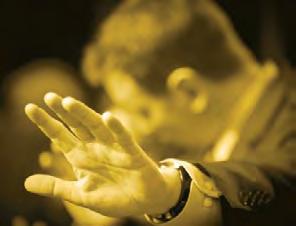
• Corporate Investigations
• Financial Investigations
• Fraud Investigations
• Asset Searching Services
• Litigation Support Services
• Anti-Corruption Investigations


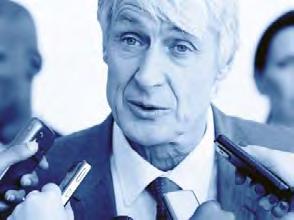
• Corporate Security & Technical Services
• Risk Assessment & Crisis Consulting Services
• Kidnap & Ransom Consulting & Response Services
• Aviation Consulting
• Resilience Consulting Services
